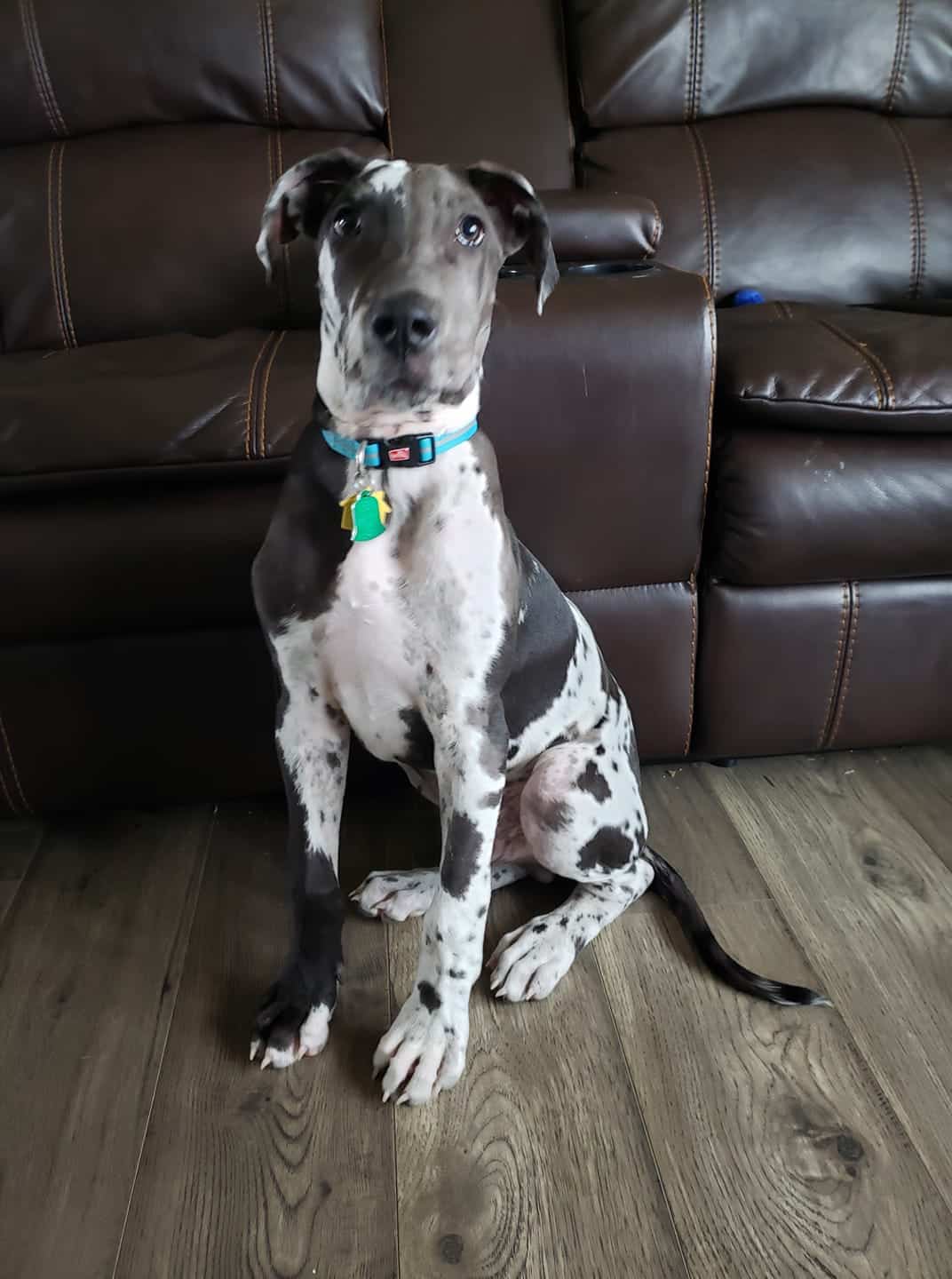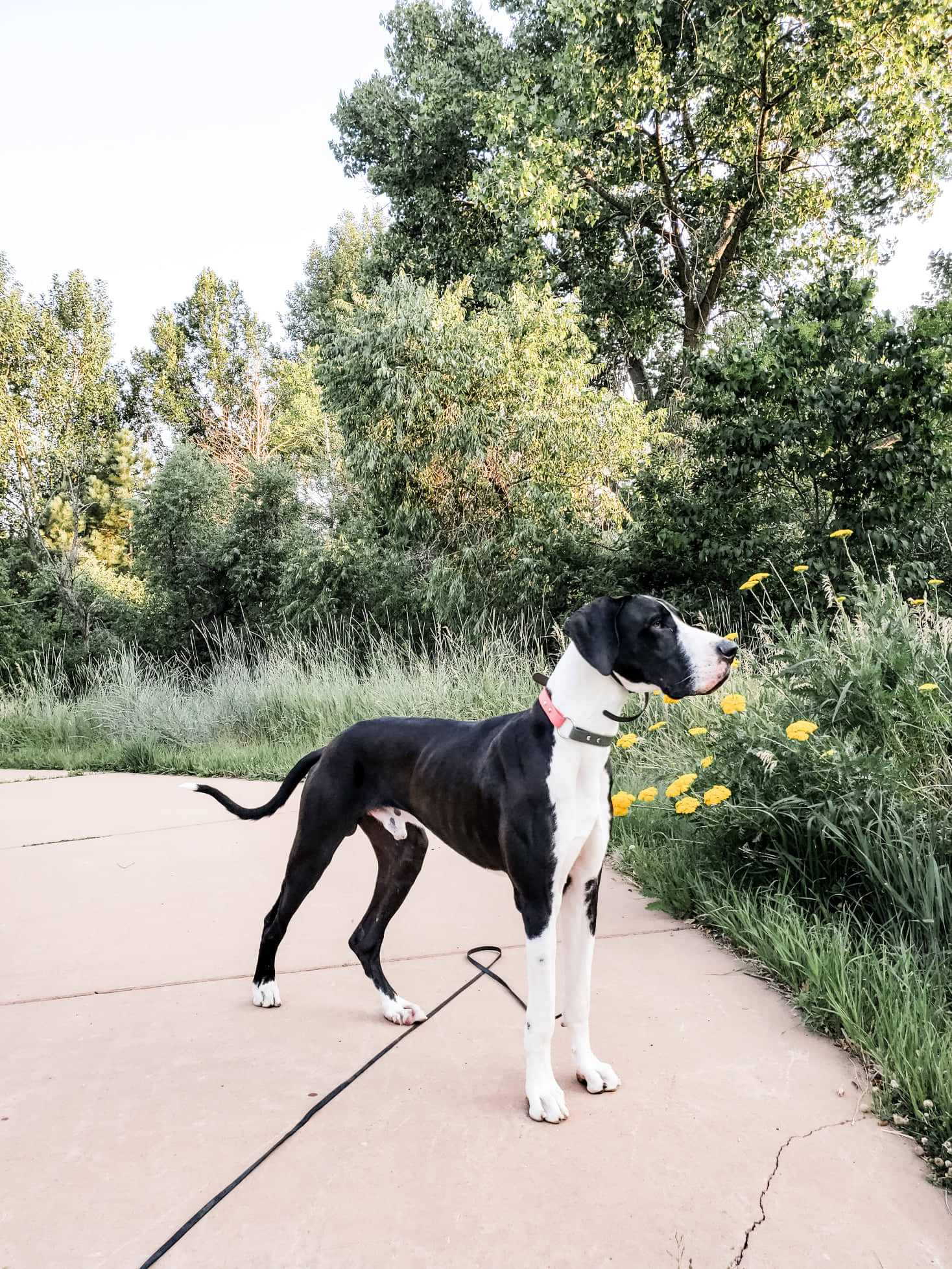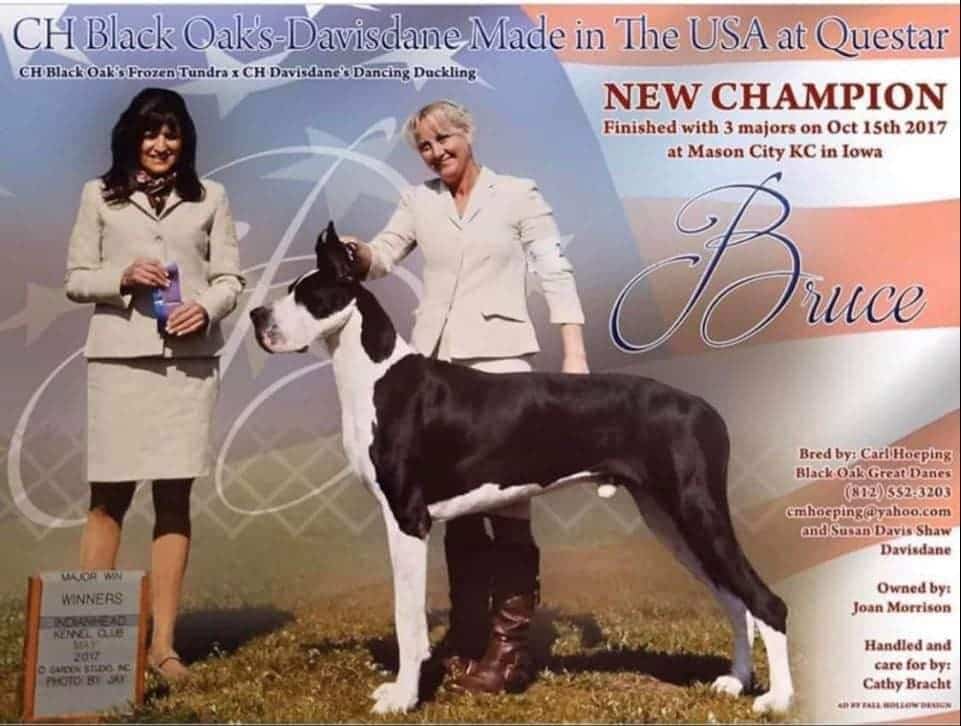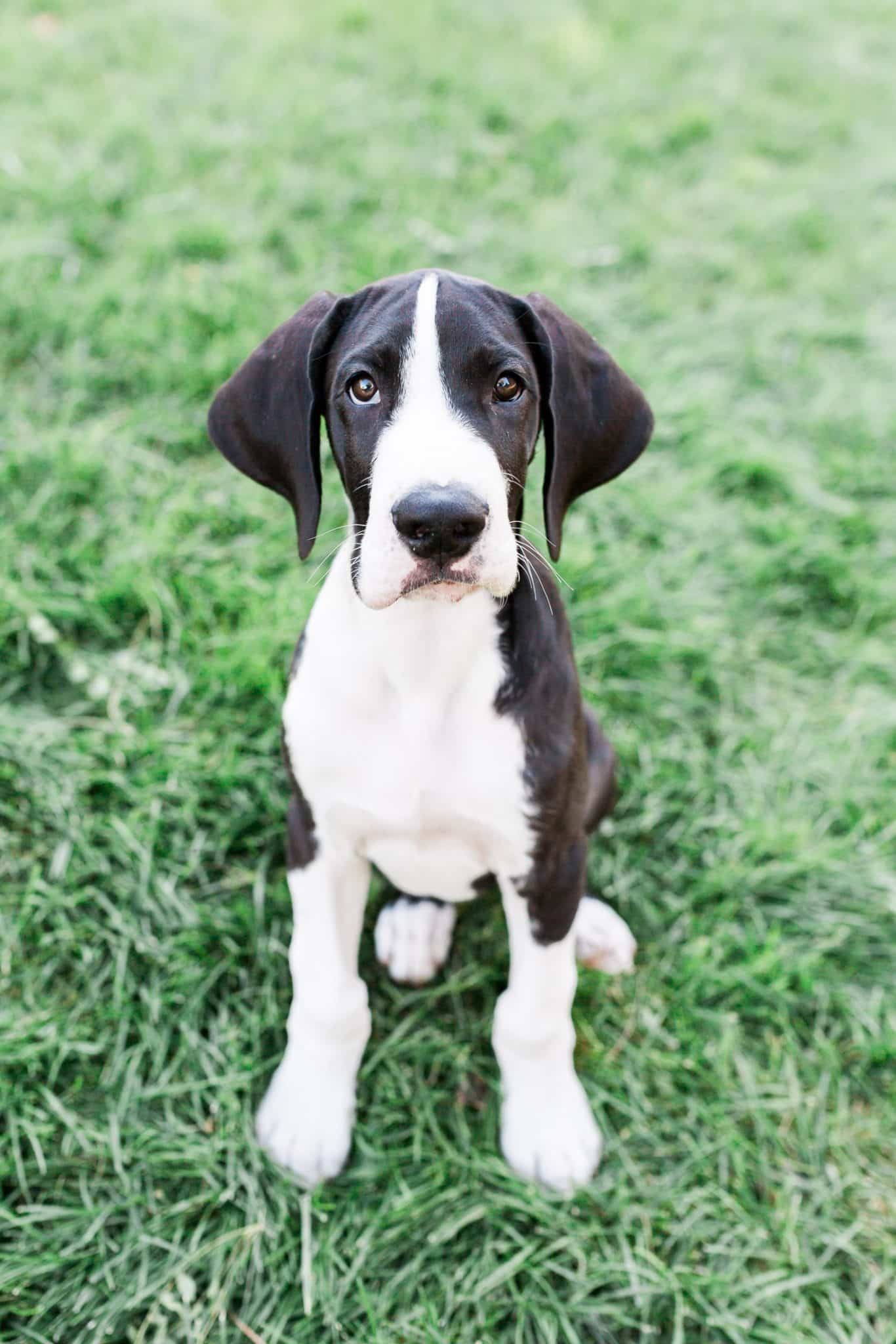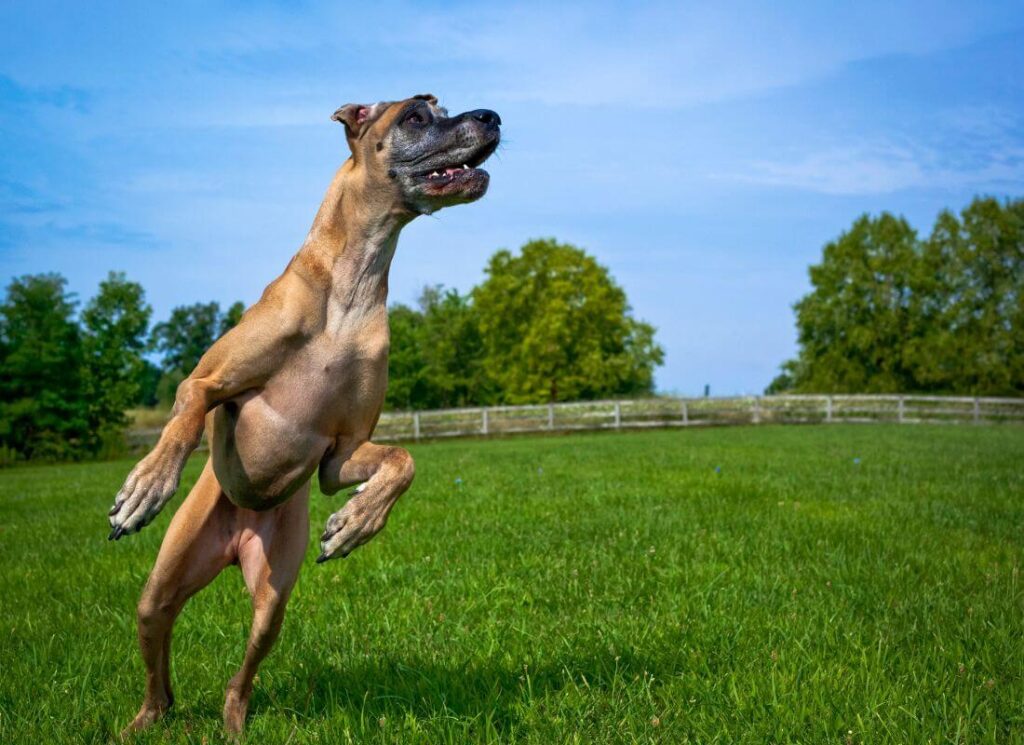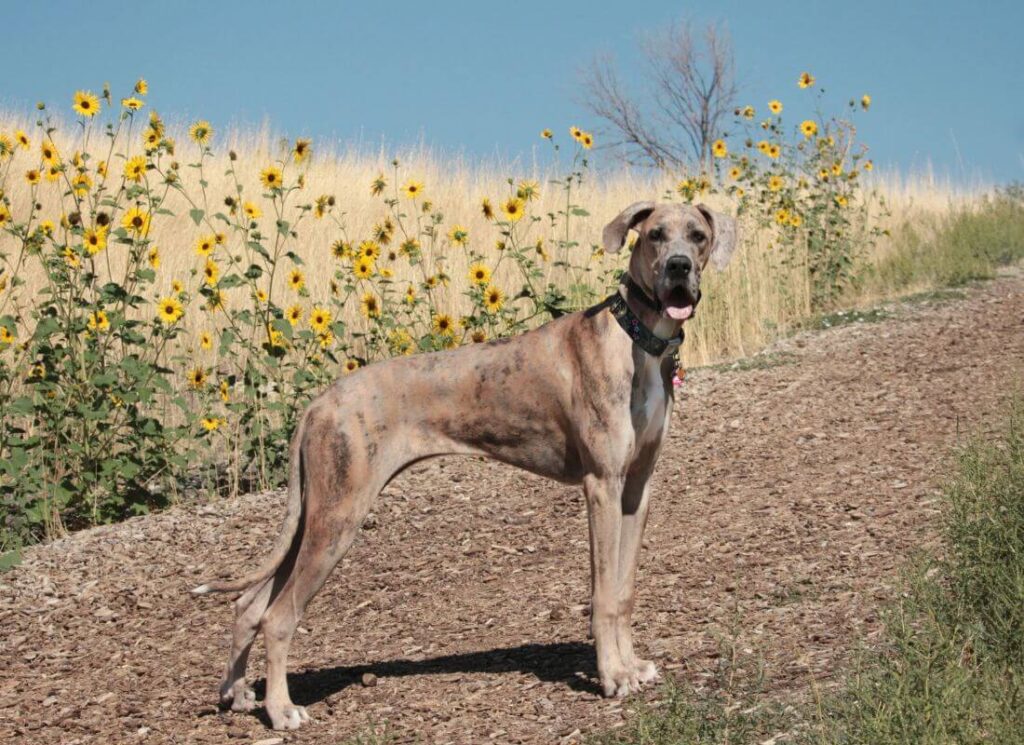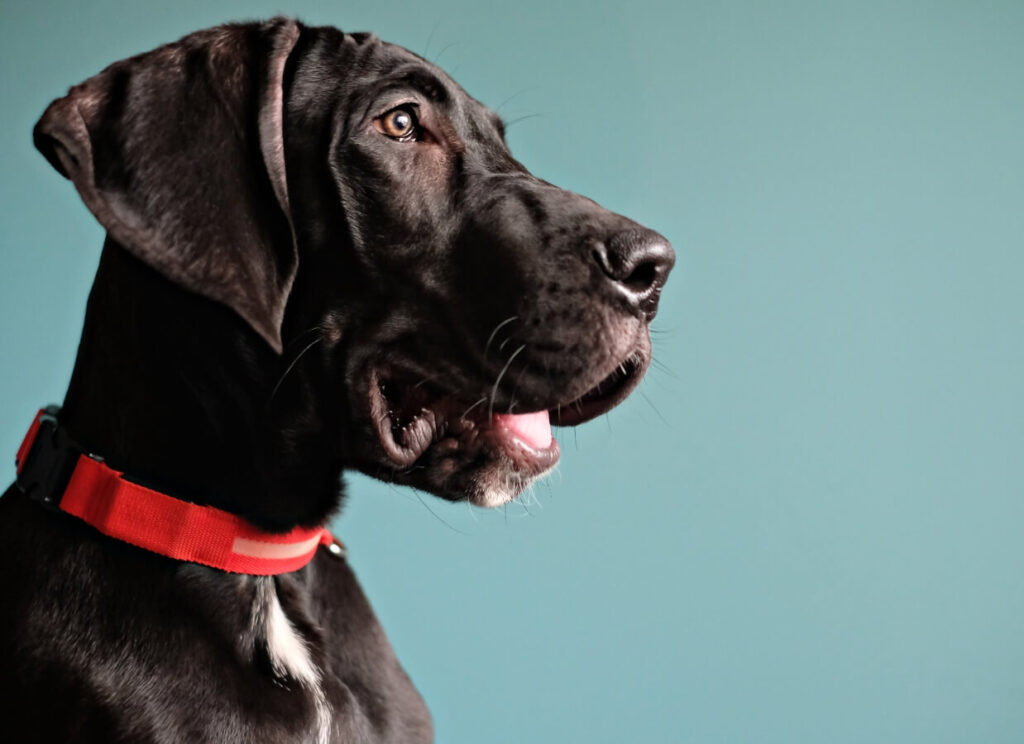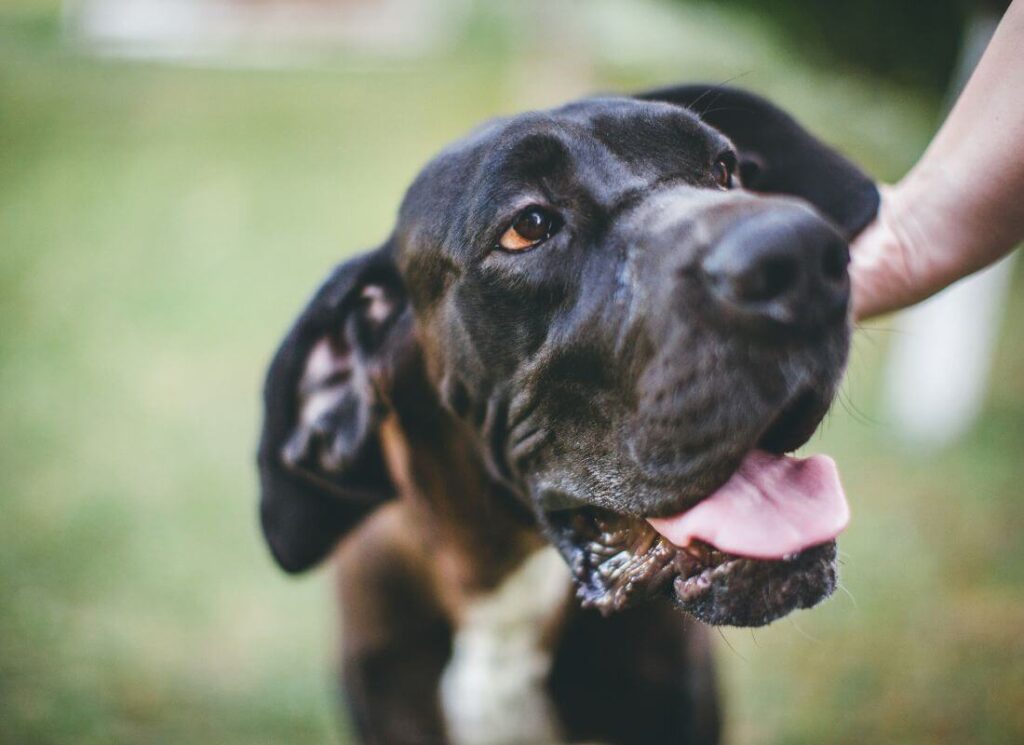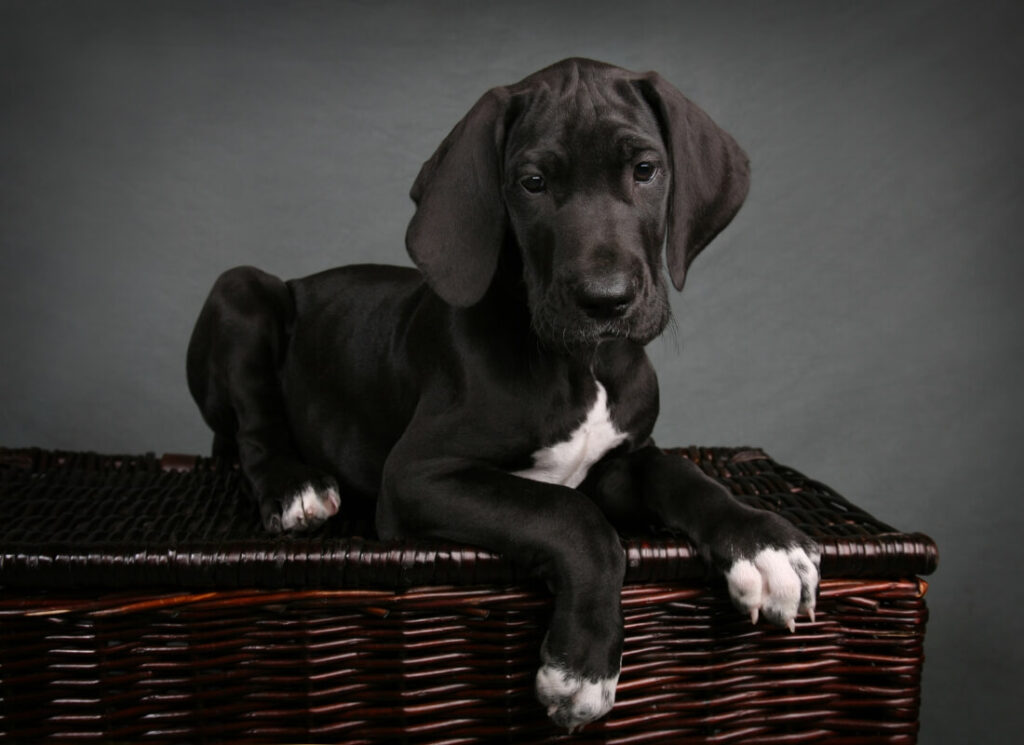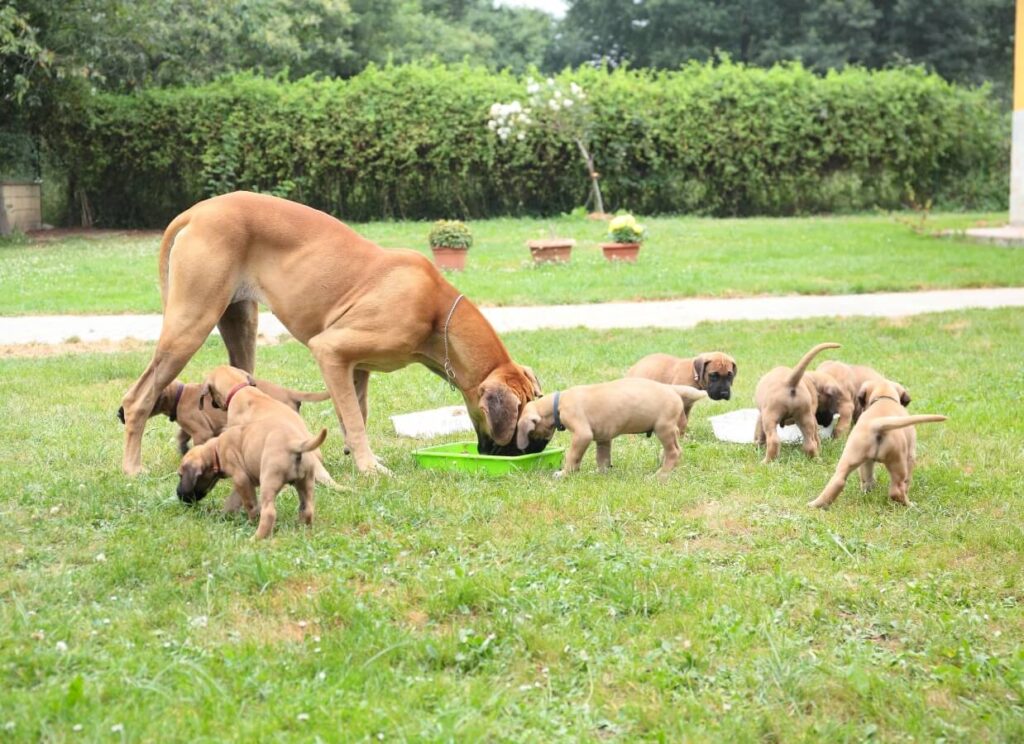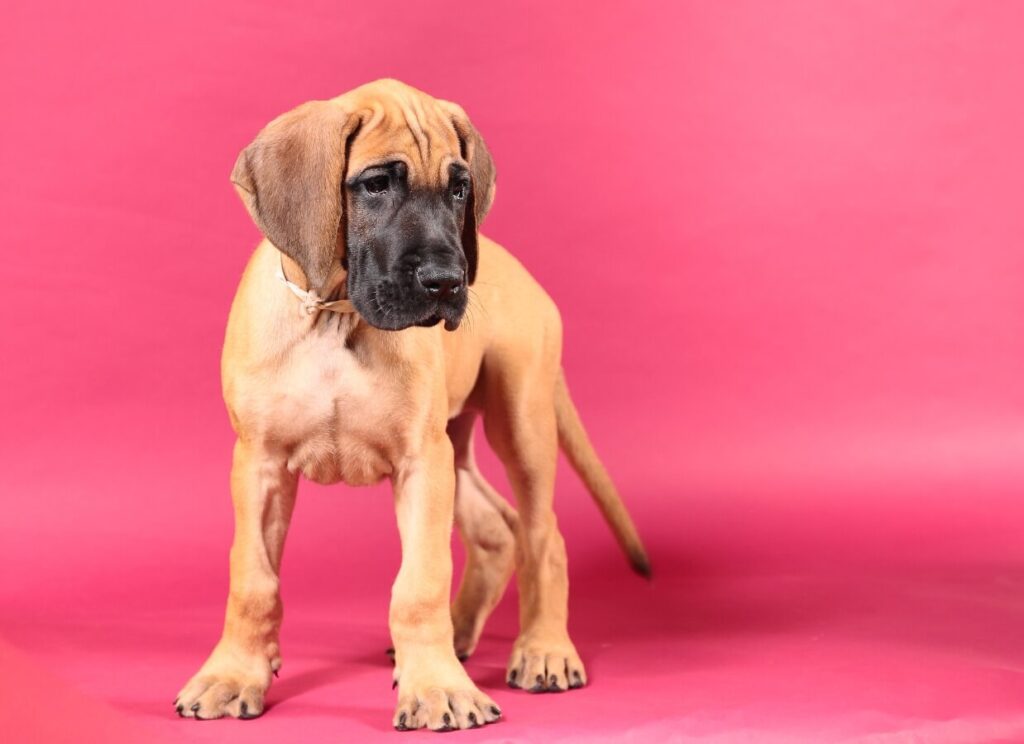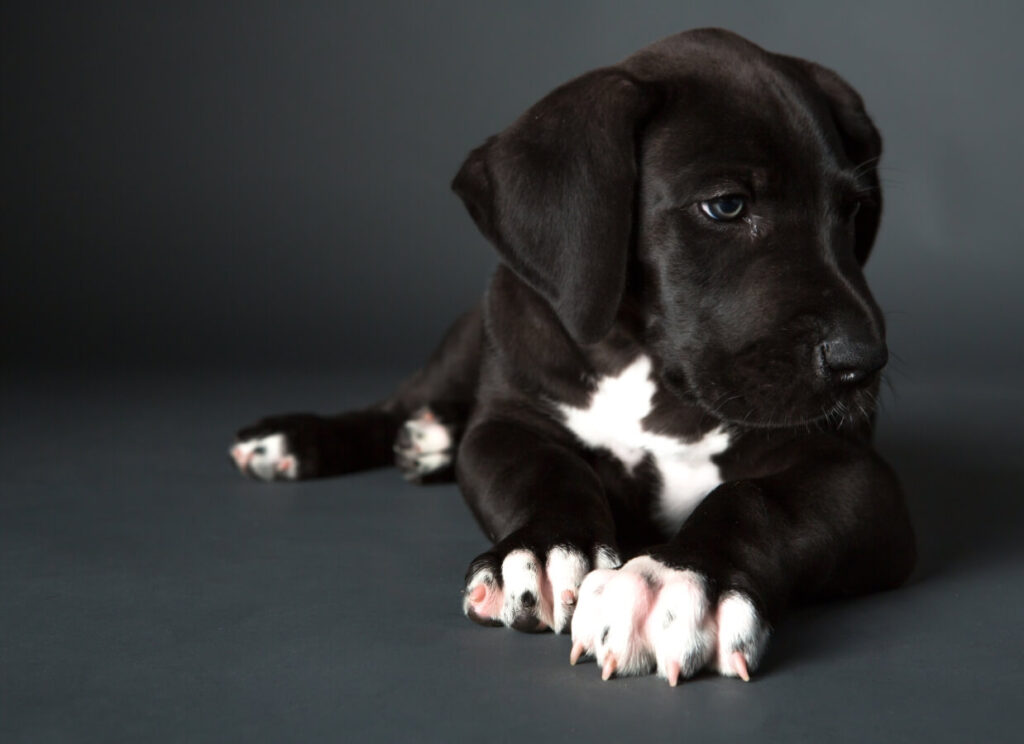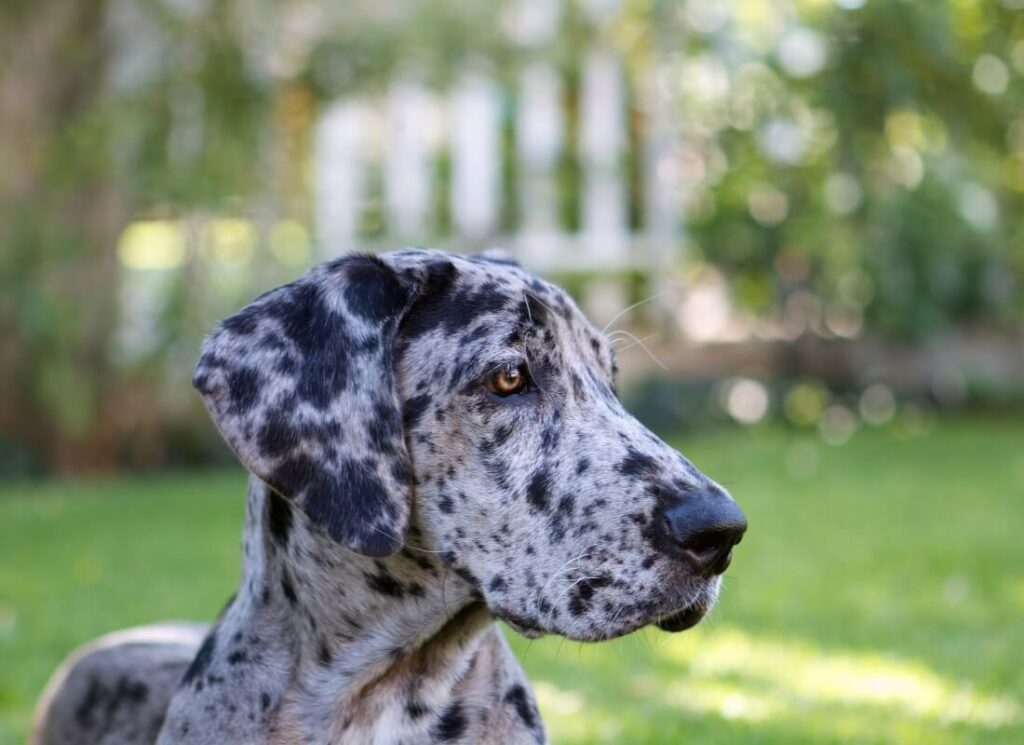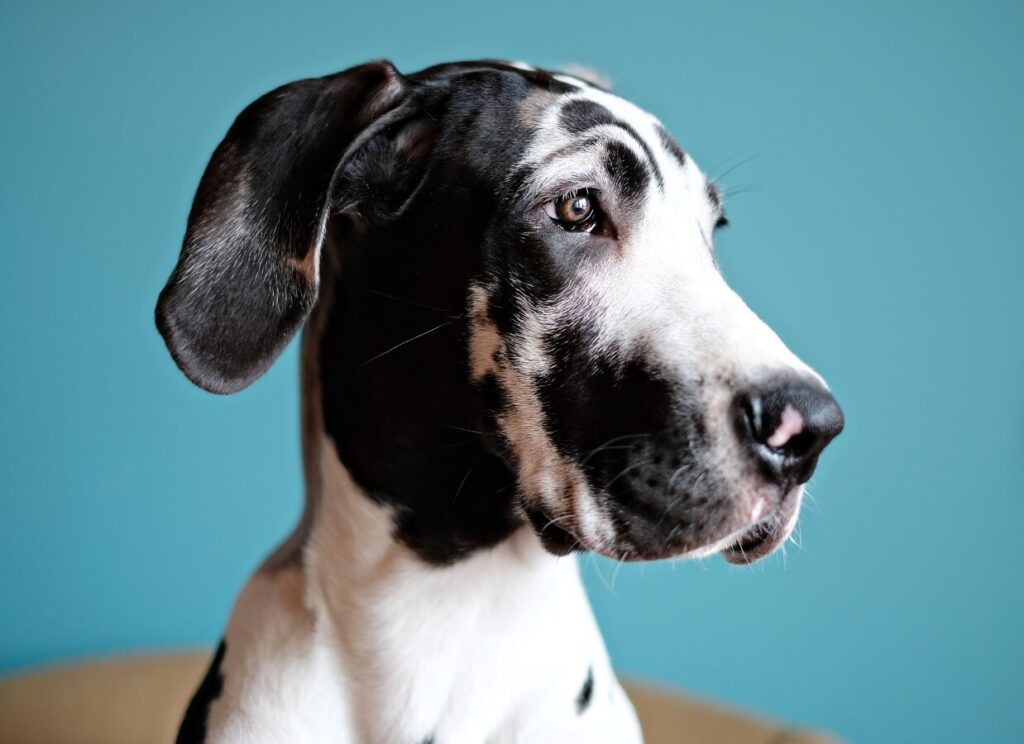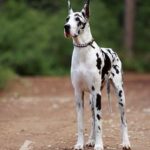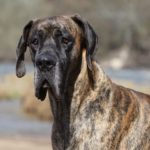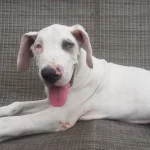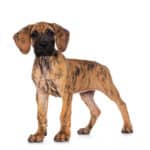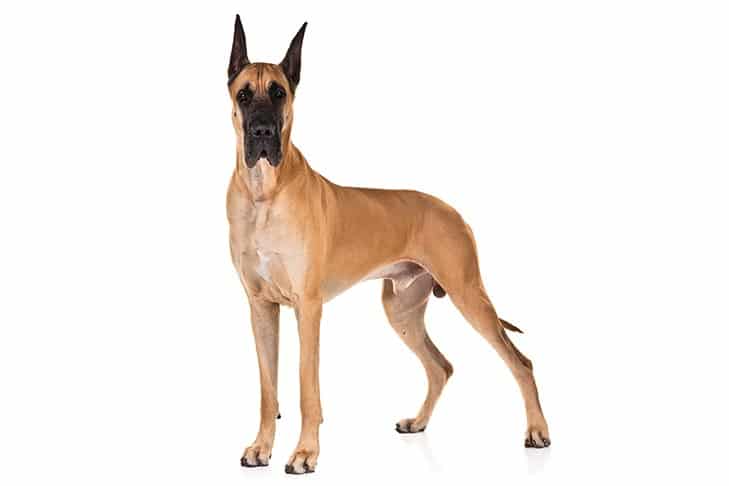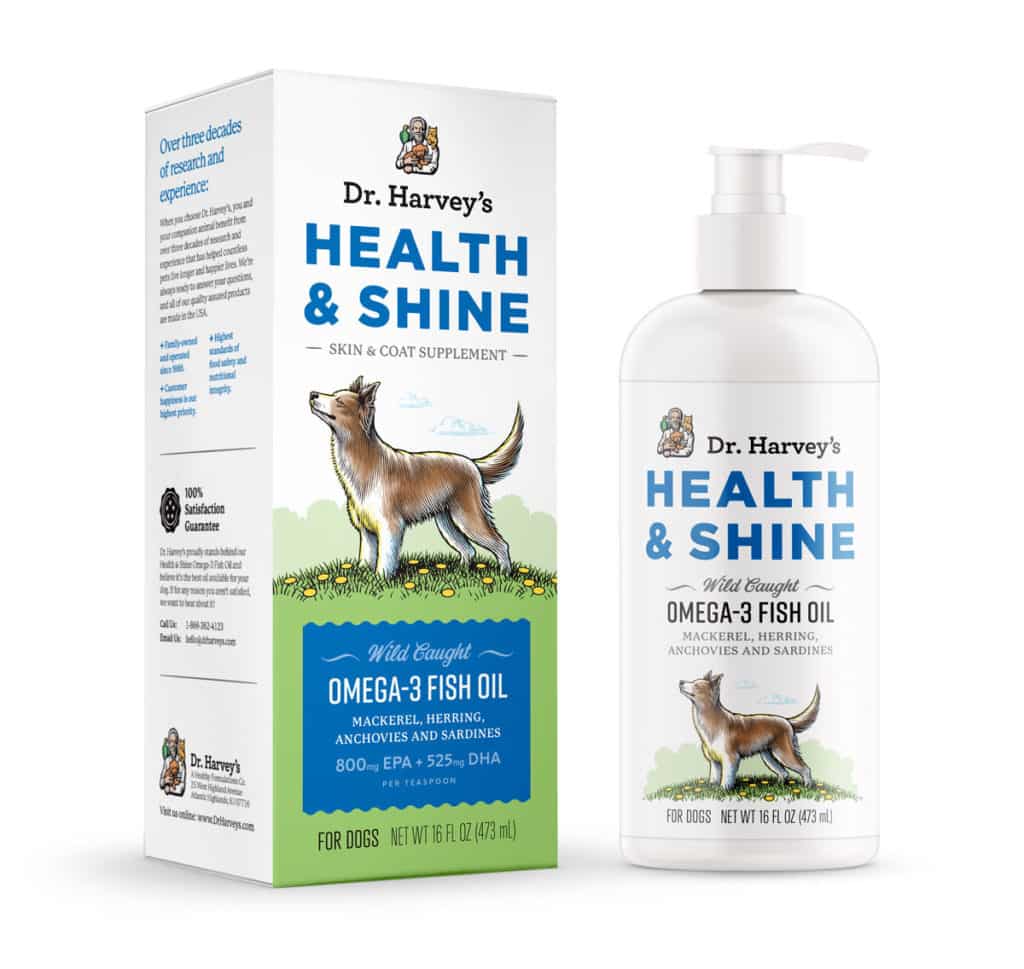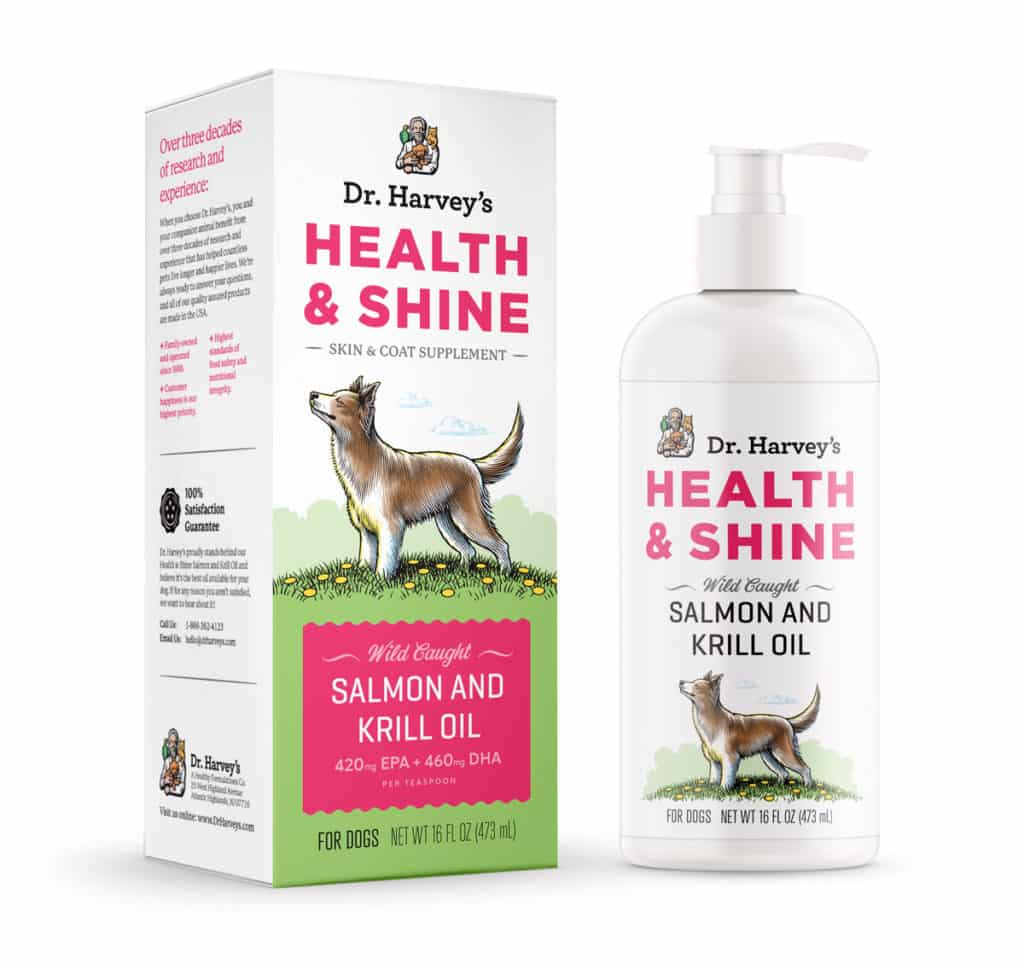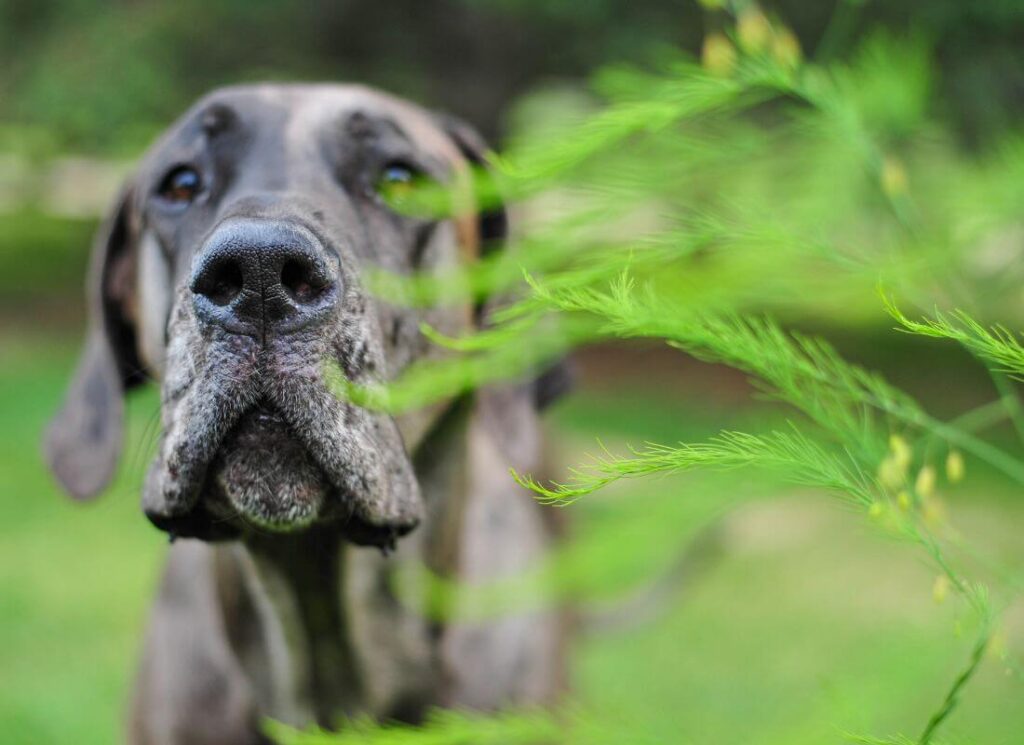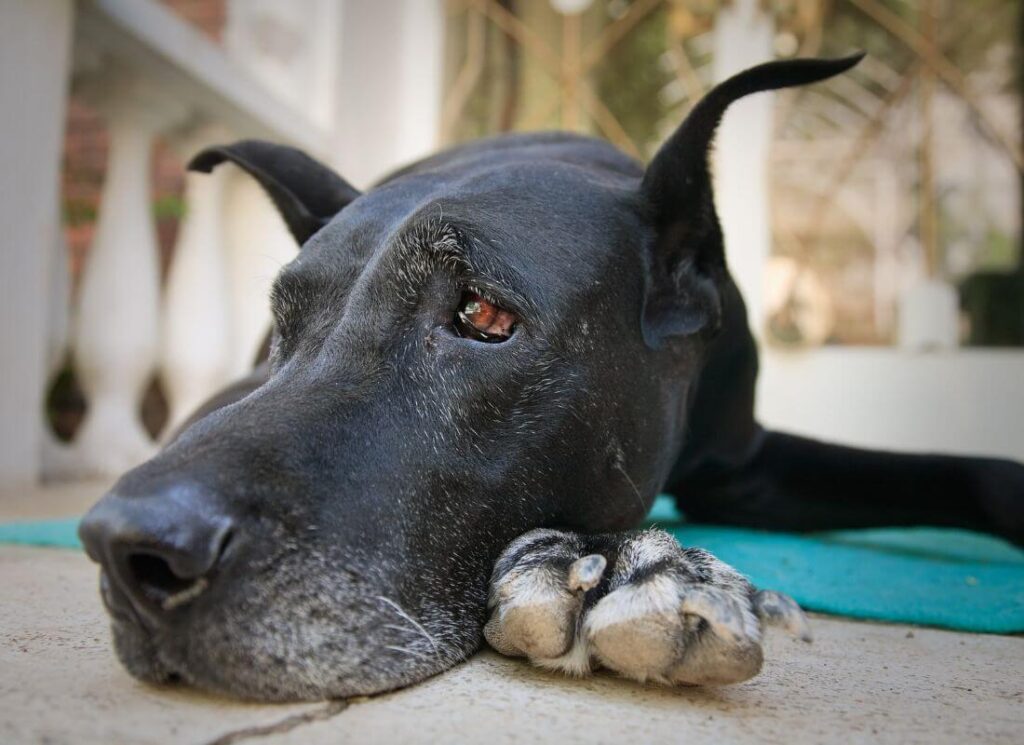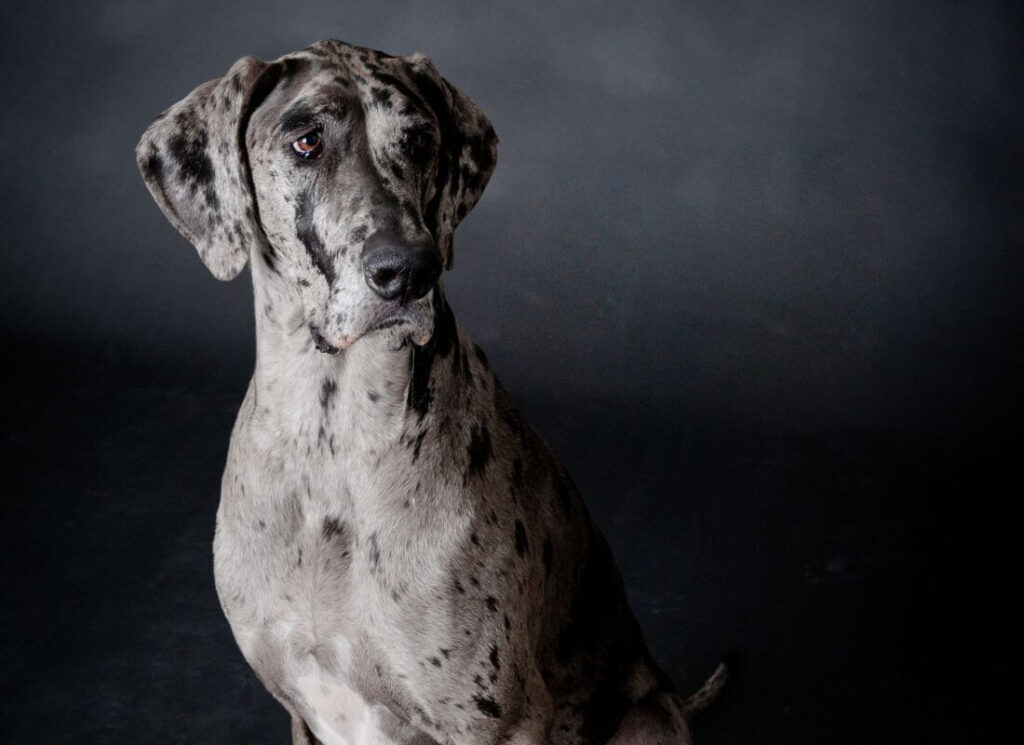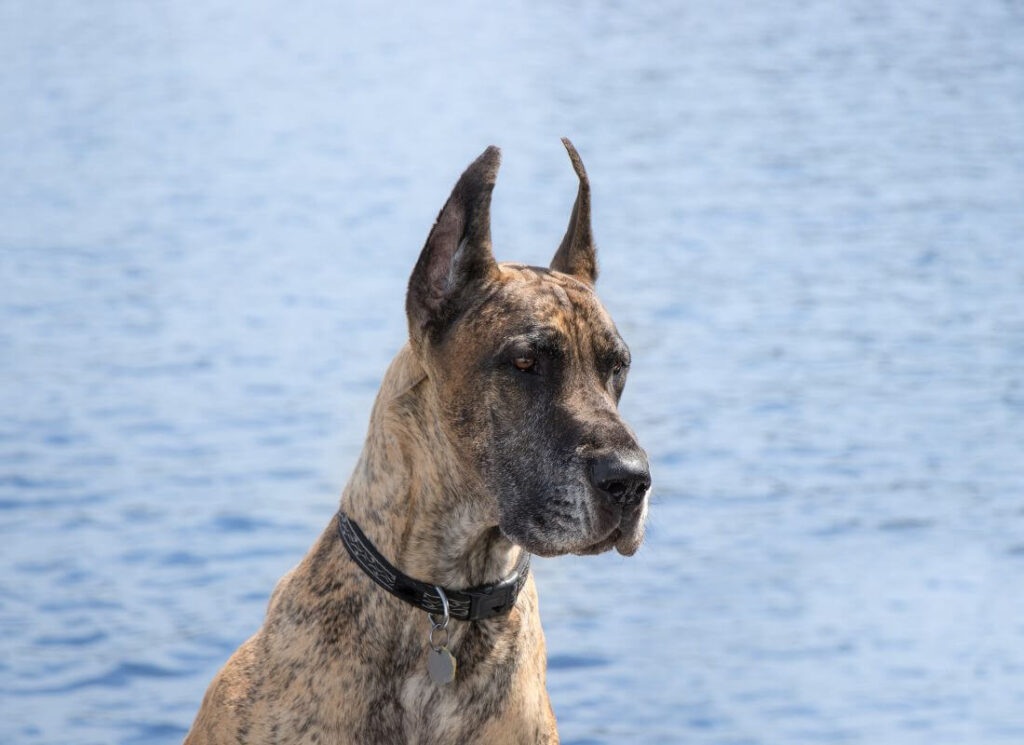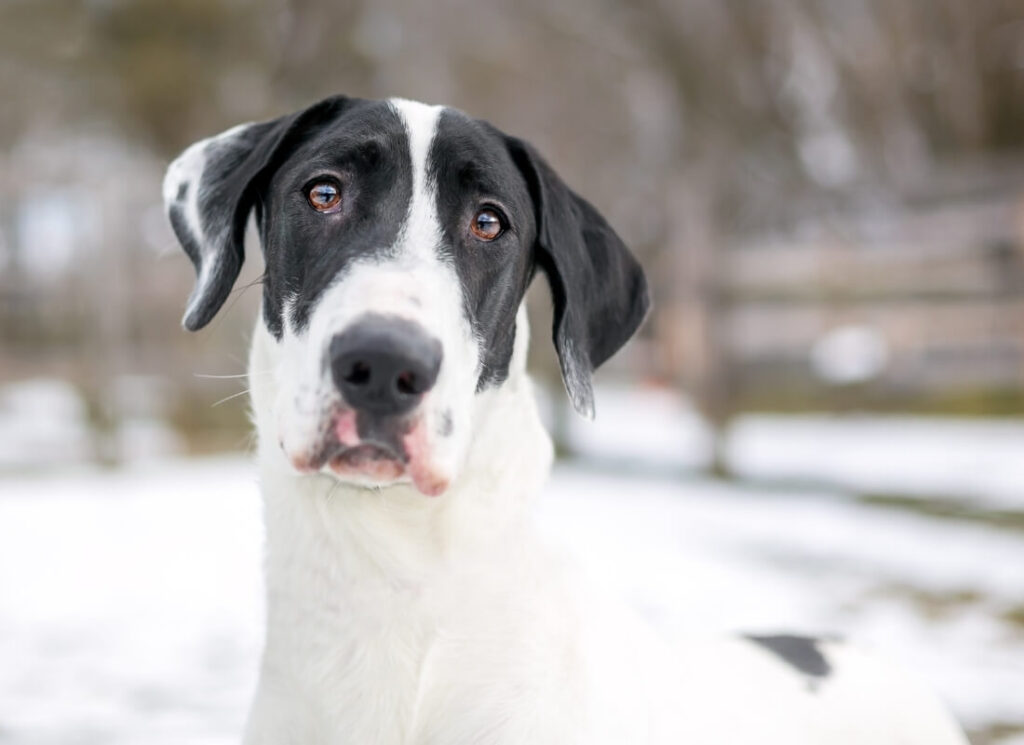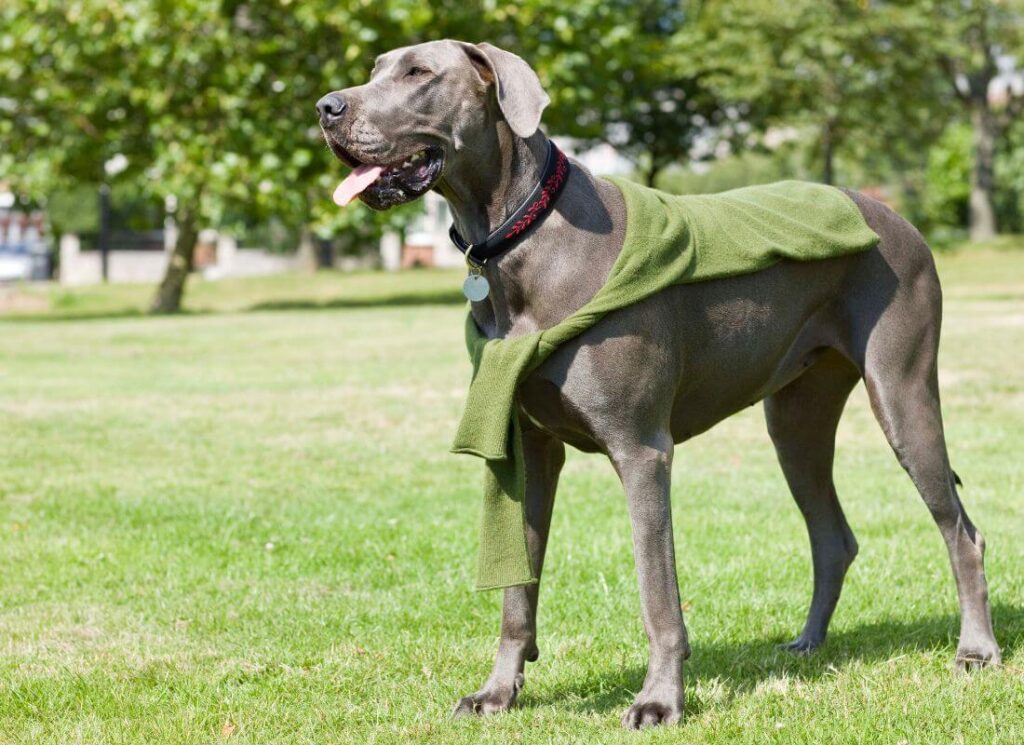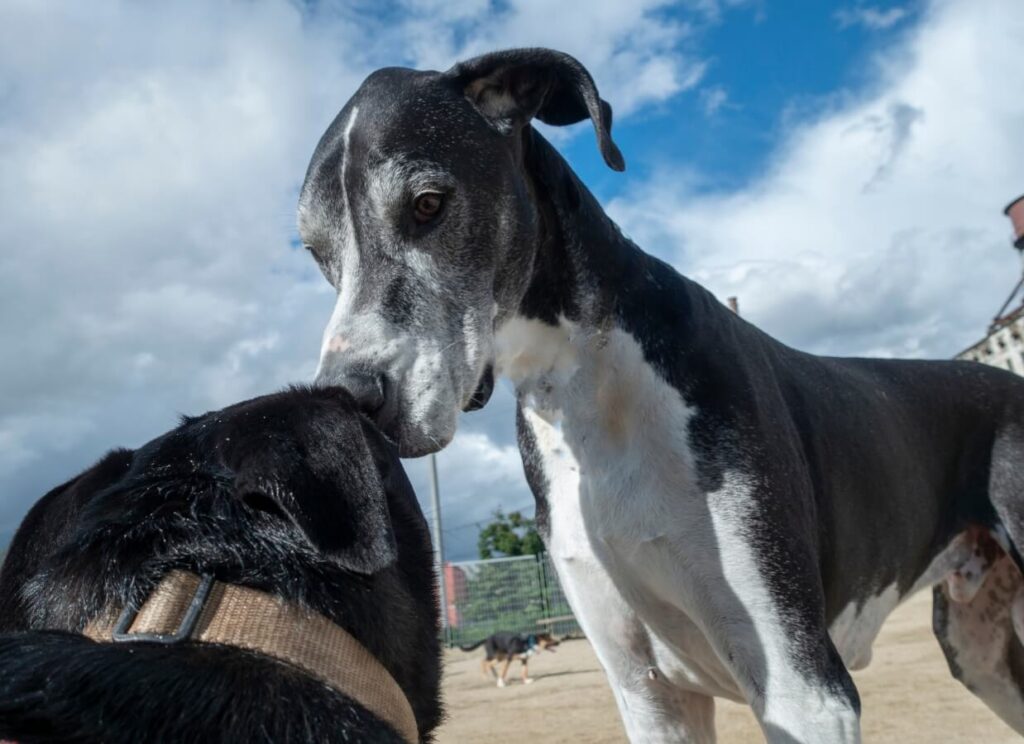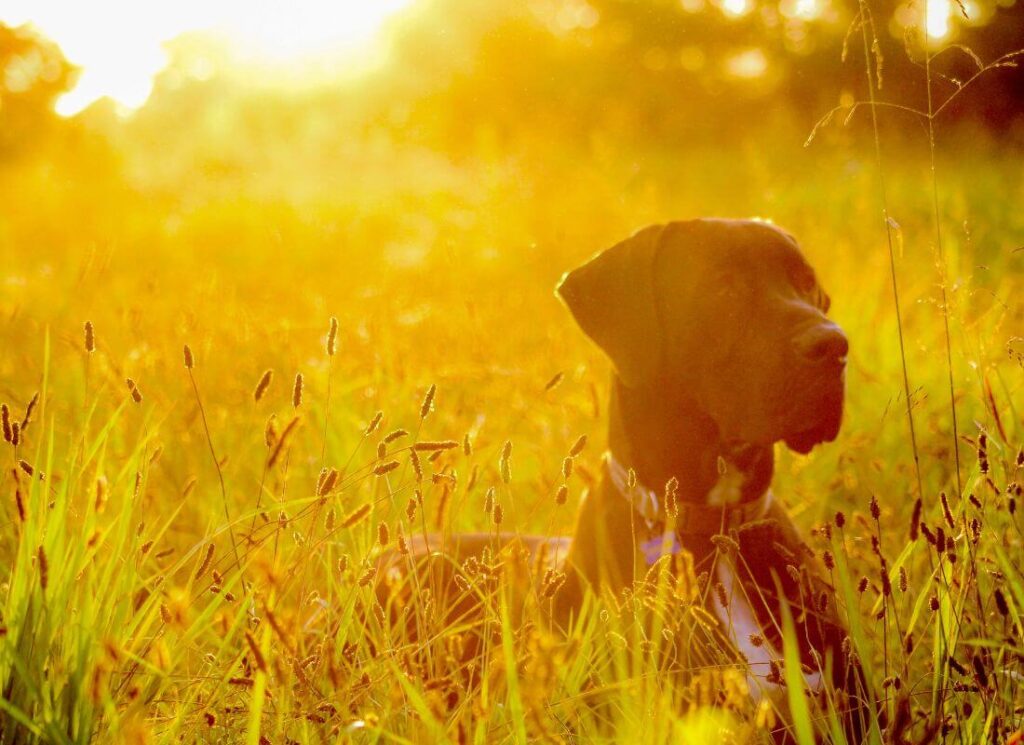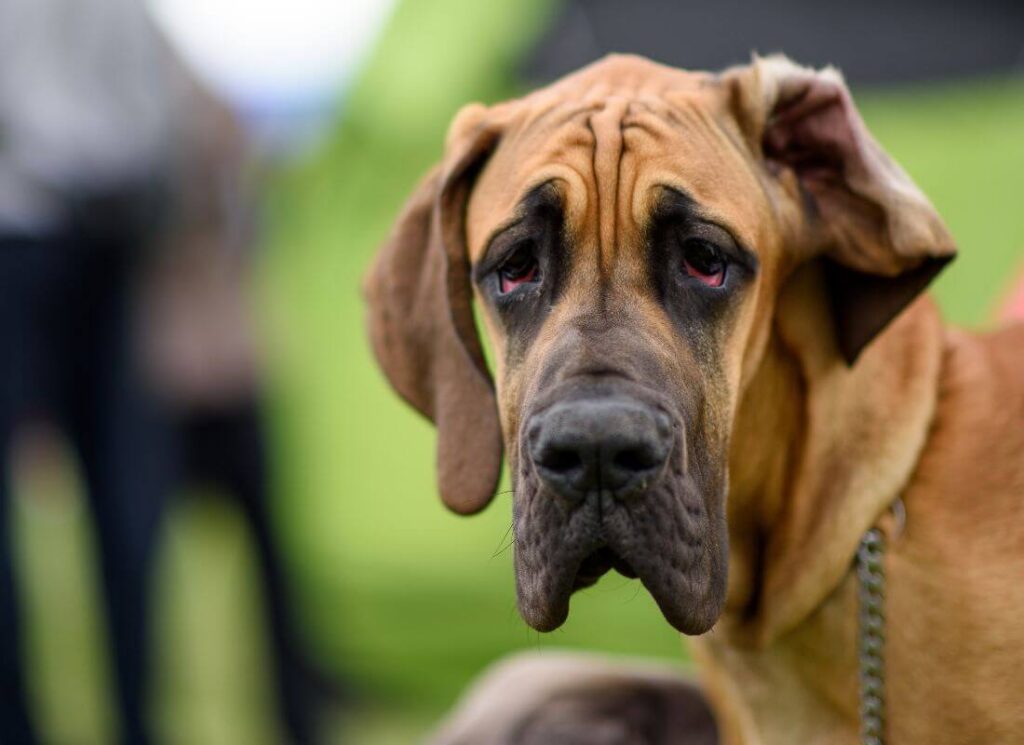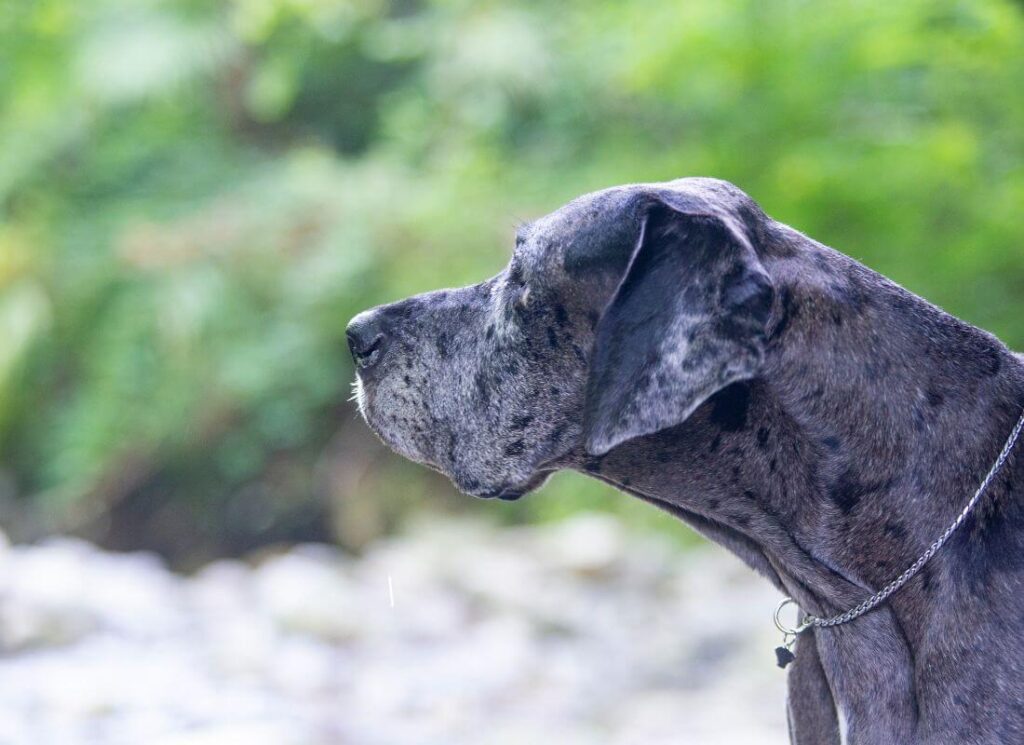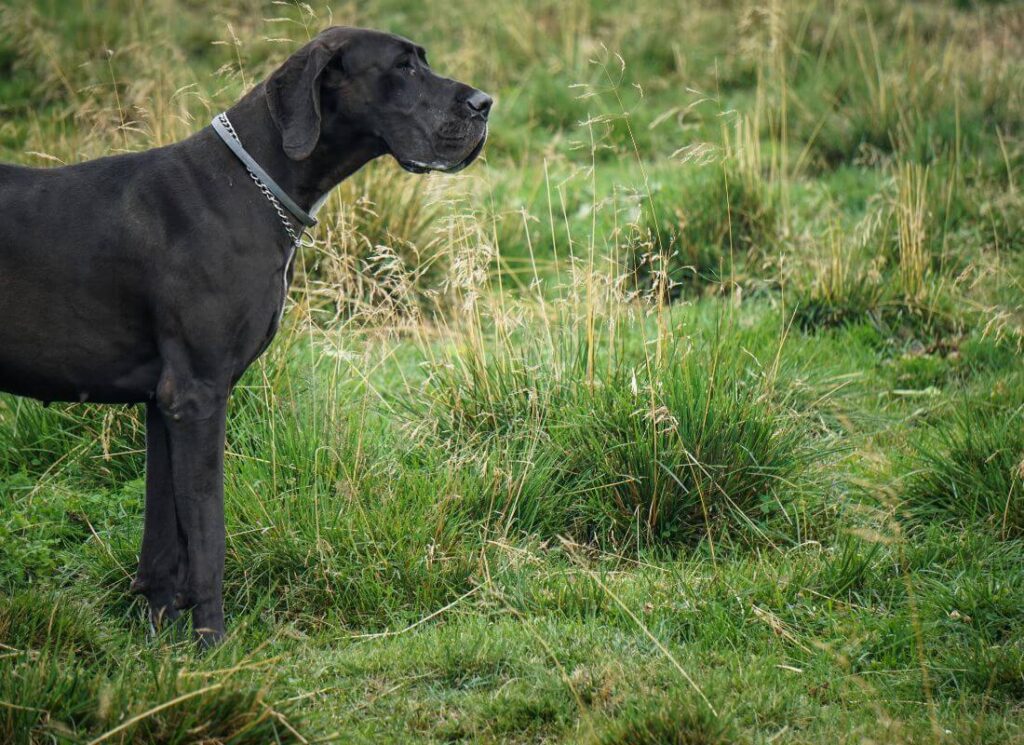I’m taking a wild guess here that you found this post because you are concerned about your Great Dane puppy knuckling over. We have many resources on this topic, and are here to help!
Great Dane puppies have HUGE knobby knees. Their limbs look so chunky when they are young that many people, even some veterinarians (who aren’t used to seeing giant breed dogs) are initially alarmed. Knuckling Over (medically known as “carpal laxity”) is a condition where the puppy’s front legs bow out over the tops of the feet.
This reversible problem is believed to be the result of excessively fast growth, environment, genetics, and incorrect nutrition. We will touch on all of these factors below!
- What causes puppy knuckling over?
- Are flat feet and knuckling the same thing?
- How to treat puppy knuckling and carpal laxity
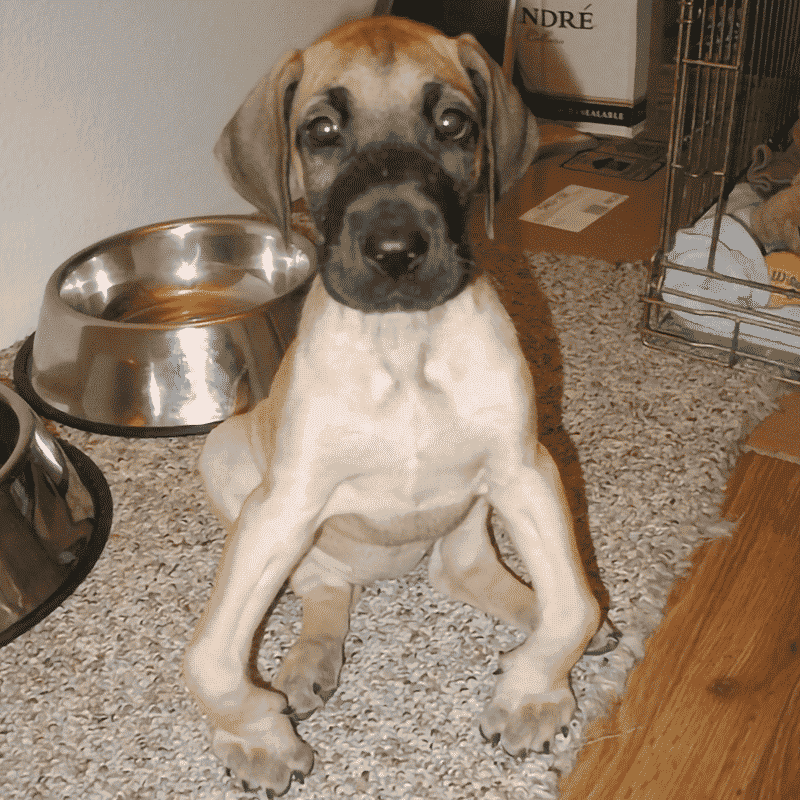
Great Dane Puppy Knuckling Photos
Here are some photos of Great Dane puppies who are experiencing severe carpal laxity (“knuckling”). Your puppy may have only mild knuckling that could progress quickly if left untreated and may not yet look like the puppies below.
Any kind of bowing out, flat toes, or crooked appearance is cause for concern. While carpal laxity knuckling is the most common growth disorder, it’s also the most benign!
Other problems related to bone growth in Great Danes include HOD, Panosteitis, Angular Limb Deformity, and Osteochondrosis. If you see ANY kind of abnormality in your puppy’s feet, you must visit your veterinarian to rule out more serious conditions.
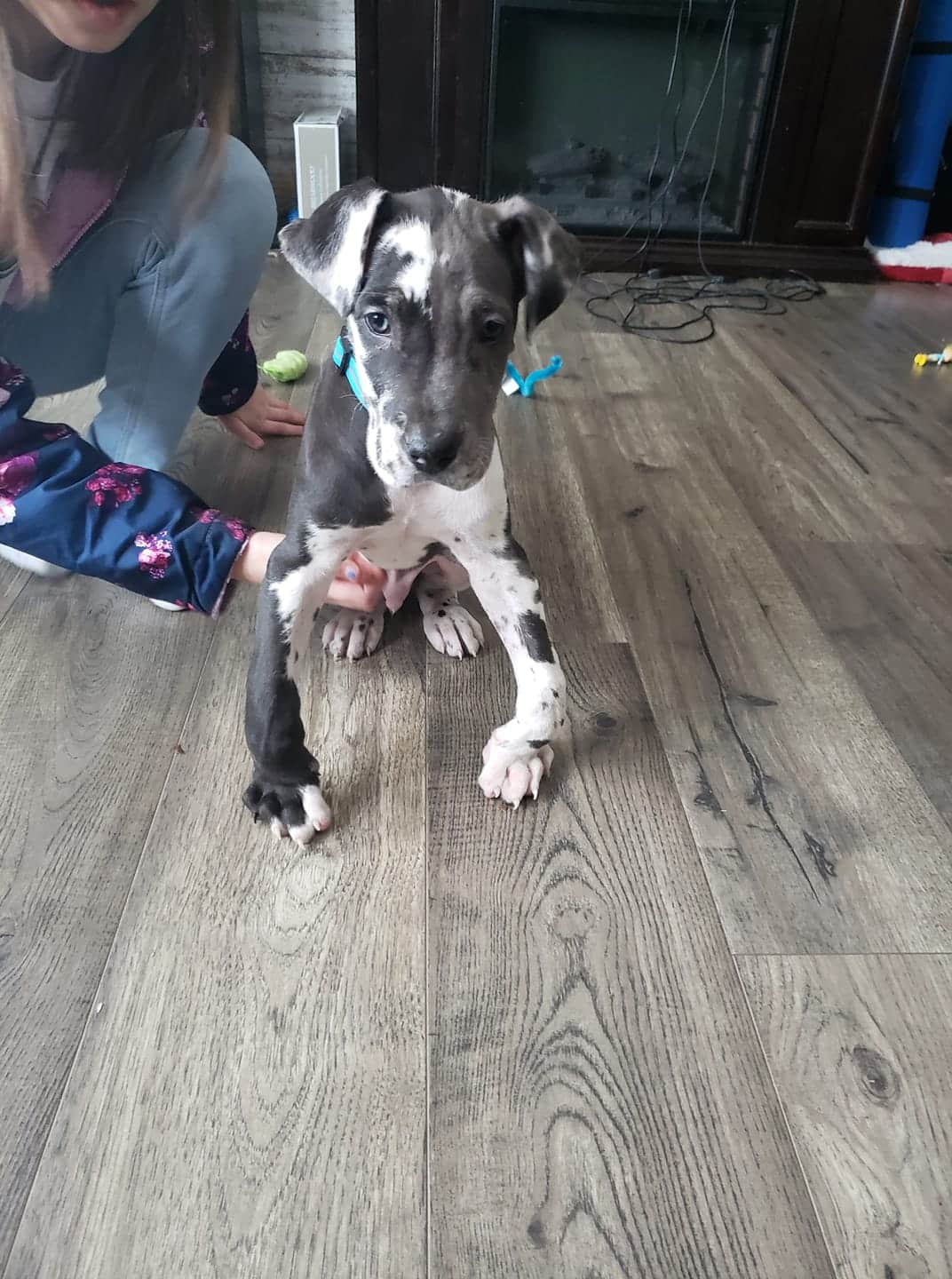
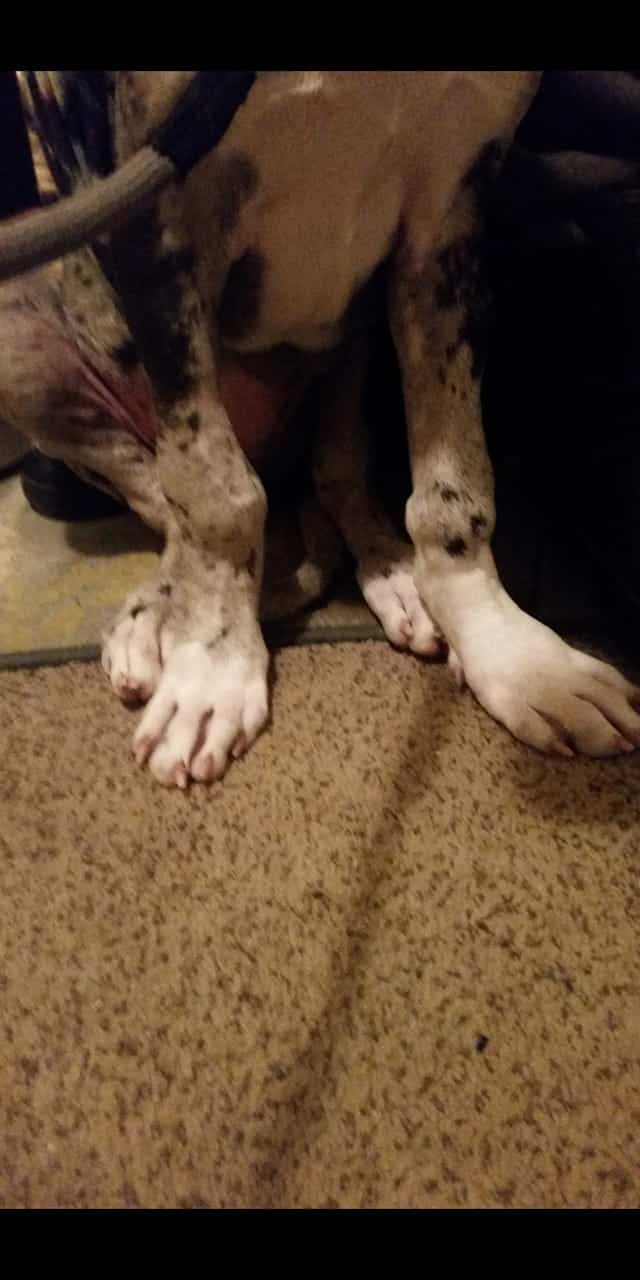

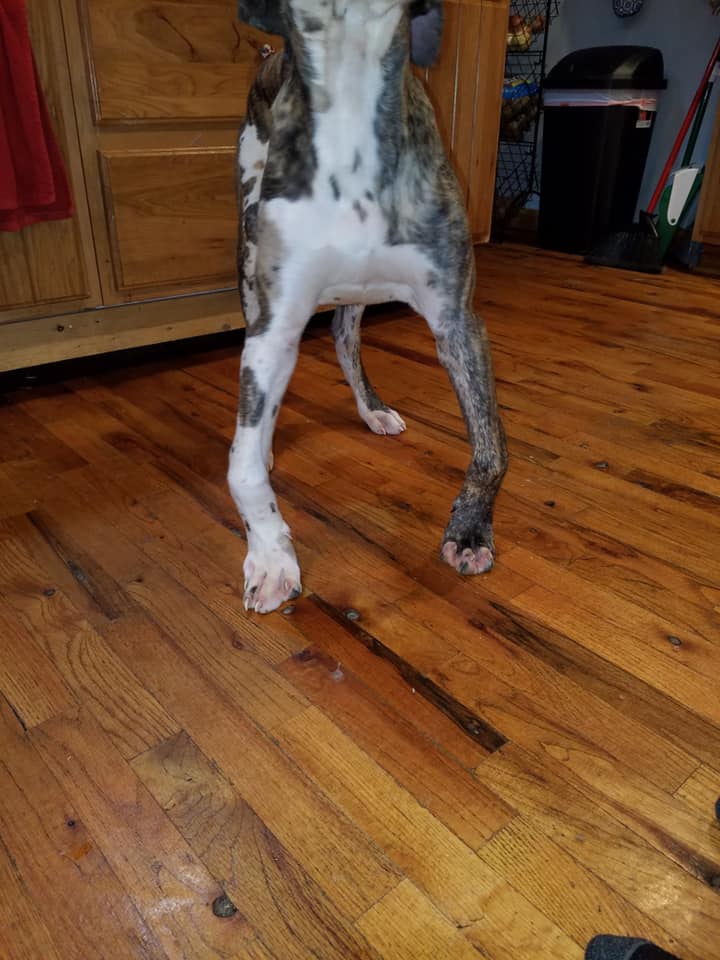
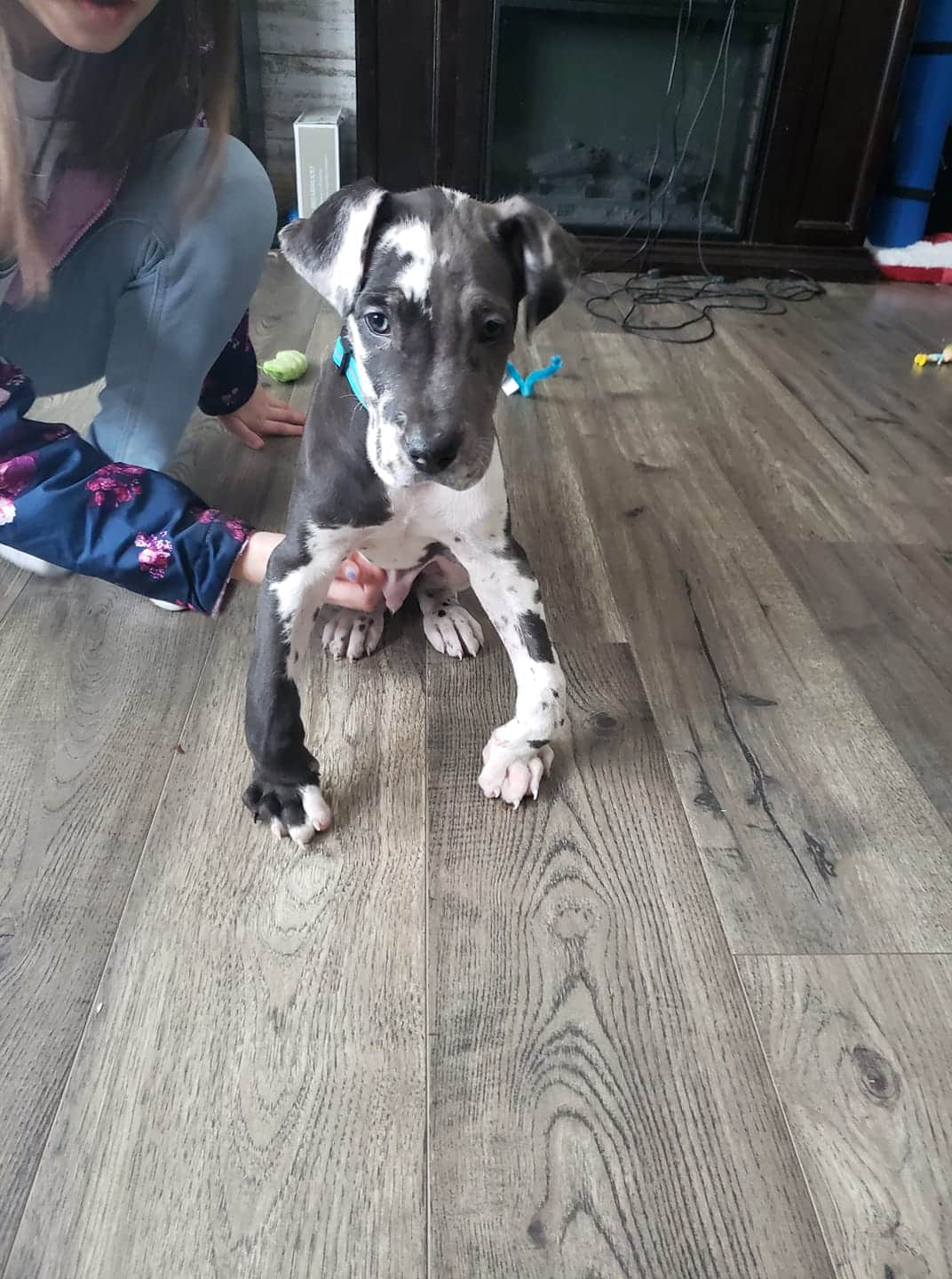

Normal Great Dane Puppy Legs
For reference, the image below is a young Great Dane puppy with normal legs. Notice the growth plates; those bumps are normal. The feet are nice and tall, and the limbs appear to hold the puppy up without any struggle or bowing out.
Having solid feet and good foundations are so important for growing giant breed dogs. At this age, the joints and growth plates are very soft and susceptible to damage.
The bump above the patella (or, the ‘ankle’) may be alarmingly large! Many people mistake this for knuckling in Great Dane puppies. If that bump is swollen and warm, that is concerning. However, it’s not unusual for them to be knobby in substantial, well-boned Great Dane puppies.
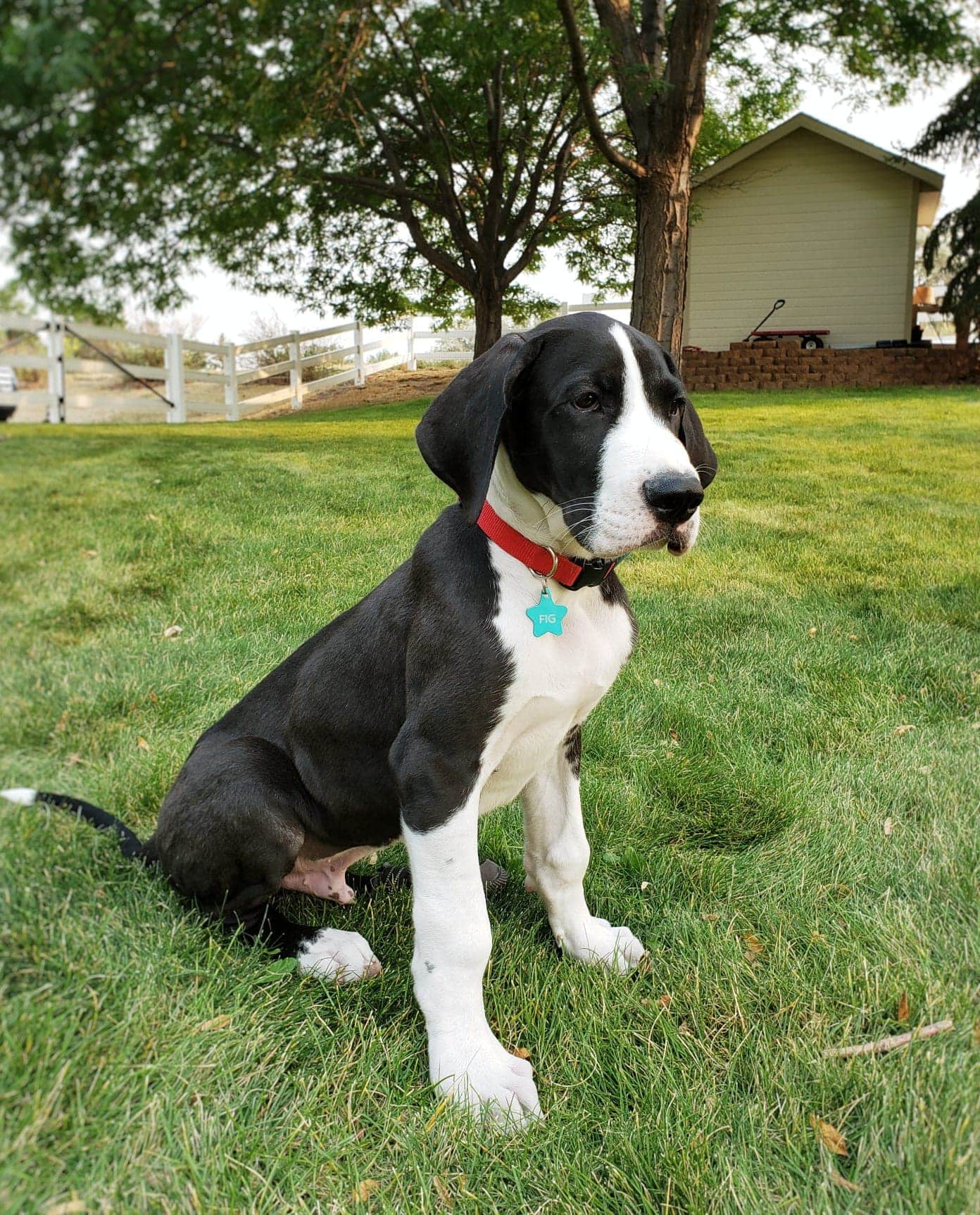
Great Dane Health Issues & Orthopedic Growth Disorders
It is super important to note that while it may be normal for Great Dane puppies to have large growth plates, they should still be strictly monitored.
Excessive swelling of the growth plates and obvious signs of pain are red flags and warrant a visit to the veterinarian. A struggling Great Dane puppy may limp, appear weak or lame, wobble, whine, chew on their feet and/or have a strange gait when they walk.
Warm growth plates and flat or turned-out feet or limbs are another sign that something is wrong.
Some common Great Dane growth disorders include:
- HOD – Hypertrophic Osteodystrophy is a painful disorder in growing large and giant breed puppies that can cause swelling and abnormally large limbs and joints.
- PANO – PANOSTEITIS is also known as growing pains, and can cause swelling and pain.
- OSTEOCHONDROSIS
- INJURY – Injury to the growth plate may be serious and can cause swelling and permanent damage (that may develop into angular limb deformity or similar).
As before, consult with your veterinarian if you are unsure! Even severe cases start with a mild version, so keep an eye on your puppy and take day-to-day photos if you are concerned.
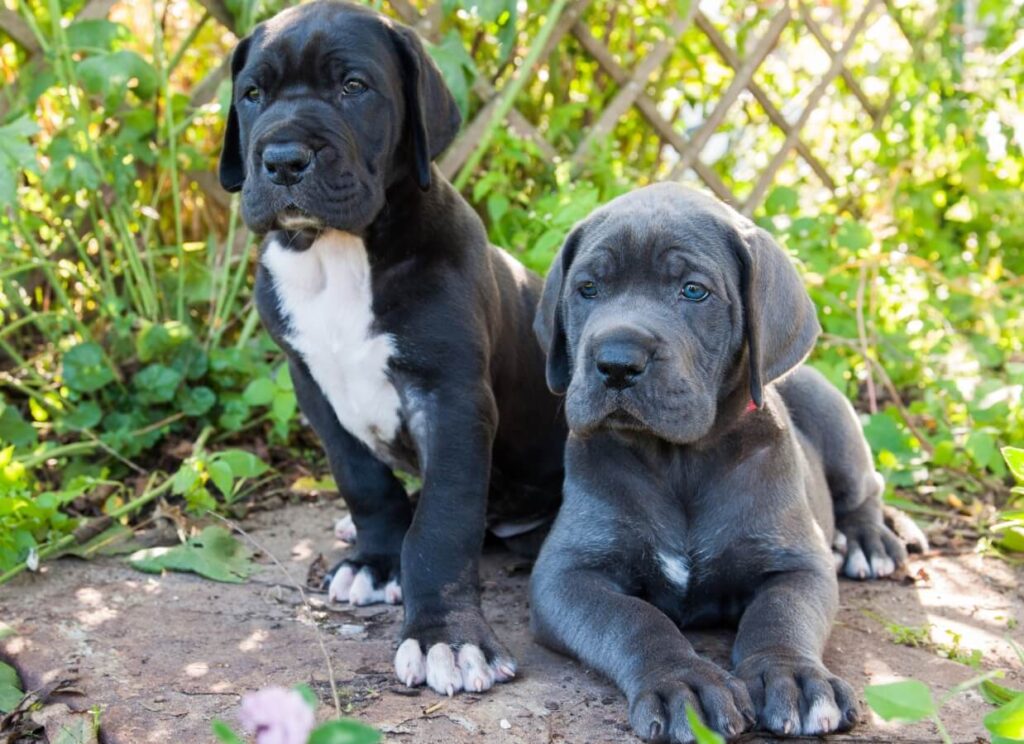
What Causes Knuckling in Giant Breed Dogs
While the exact cause is unknown, it is believed that knuckling (carpal laxity), and all other orthopedic growth disorders are related largely to diet and an imbalance of important minerals and nutrients.
Excess intake of calcium has been shown in studies to contribute to improper growth. Osteochondrosis, HOD, Panosteitis, and even angular limb deformities are commonly associated with too much calcium.
Great Dane puppies utilize nearly EVERY bit of the calcium they receive in their diets. Adult dogs are better able to regulate this and discard what they don’t need. This makes it very important that we control the amount of calcium our puppies (under the age of 2) are receiving.
Never feed a diet with more than 1.2% calcium to a Great Dane puppy! If it’s not listed on the bag, contact the company.
In addition to excess calcium intake, excess food intake (overfeeding) results in obesity and rapid growth. This creates a perfect storm that results in all kinds of deformities and disorders.
So what is the trick to reducing the risk of orthopedic growth disorders and bone problems?
Less calcium, less food. I’ll dig into this below!

The Best Food to Treat Knuckling in Puppies
Many foods on the market are NOT safe to feed giant breed puppies. I believe there are only a handful of truly nutritious and correctly balanced choices.
When choosing food for a Great Dane puppy, especially if they have any kind of carpal laxity or painful growth disorder, you need to check the values.
The calcium content MUST meet the following guidelines:
1.2% or less calcium
3.5g or less calcium per 1000kCal
A ratio of calcium to phosphorus of as close to 1 : 1 as possible
These factors alone don’t eliminate all possible options, so to narrow it down even further, choose as follows:
- Labeled as a large or giant breed PUPPY formula or a large breed ALL LIFE STAGES formula
- Must have the “formulated for the growth of 70+ lb as adult dogs” AAFCO statement
- Includes grains (NO “grain-free”)
- Made by a company that does research and feeding trials
- Formulated by a highly qualified on-staff nutritionist (either a PhD in Animal Nutrition or a Board Certified Veterinary Nutritionist
You may have heard that Great Dane puppies should never have puppy food. This is an OUTDATED MYTH. I cannot say this loud enough. Adult maintenance diets were used in the past but they are no longer the best choice.
If you want more information on values associated with different food brands, check out the new Giant Dog Food Project website. www.thegiantdogfoodproject.com
Great Danes need food that is formulated specifically for slow, even growth.
It is also very important, when treating growth disorders, that food intake is limited and monitored. Do NOT overfeed or free feed. Eliminate all toppers, treats, and supplements.
We highly recommend a highly researched, extensively tested and scientifically formulated large or giant breed puppy kibble with balanced calcium and phosphorus levels. Our favorites are listed below.
For more information on Great Dane feeding, visit our Great Dane Feeding Chart post.
- Purina Pro Plan Large Breed Puppy – any flavor!
- Purina Pro Plan Sensitive Skin & Stomach Large Breed puppy – TOP PICK, salmon-based
- Eukanuba Large Breed Puppy (Great for active and sporting dogs)
- Purina One Large Breed Puppy (Excellent budget option)
- Hill’s Science Diet Puppy Large Breed
- Royal Canin Giant Puppy Dry Dog food (to age 12 months) – TOP PICK, PREMIUM OPTION
- Royal Canin Giant Junior Dry Dog food (8-24 months)
- Purina Large Breed Puppy Chow
Check out THE GIANT DOG FOOD PROJECT to compare brands and values.
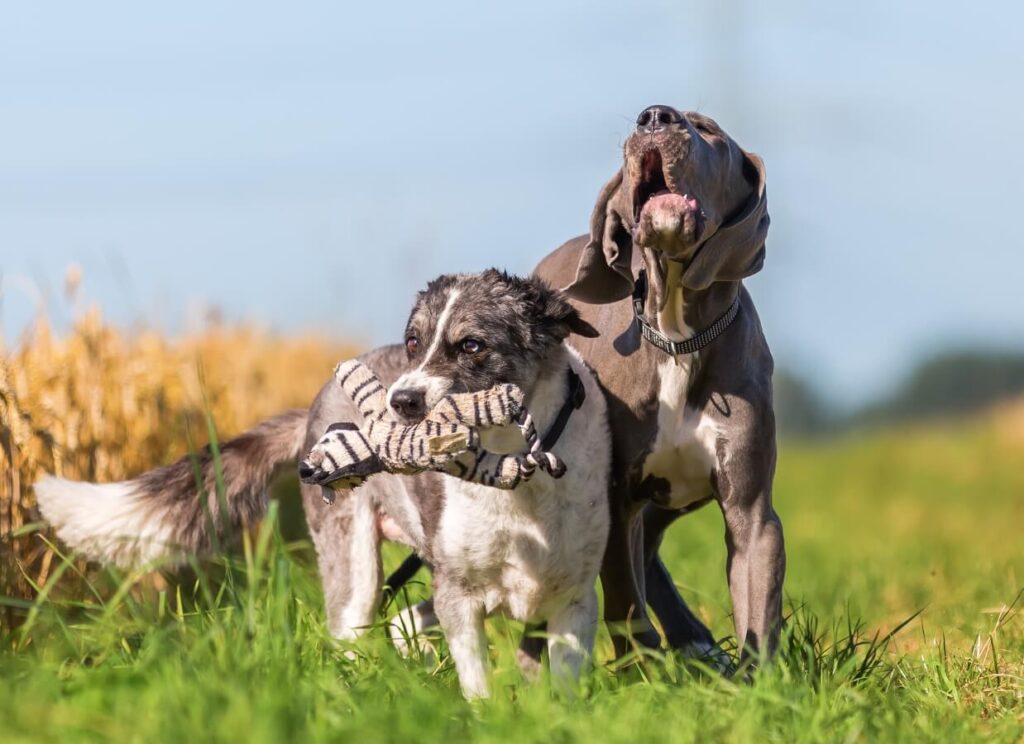
Great Dane Puppy Knuckling and Breeders
Another contributor to growth problems and bowing legs in Great Danes may be poor breeding and health practices; young puppies that are kept primarily on hard surfaces and fed an improper first diet may be more susceptible.
Great Dane puppy Knuckling occasionally goes hand in hand with flat feet (weak knuckles and toes). Poor overall foot structure has a genetic component.
Many breeders still subscribe to outdated ideas about feeding adult foods and low-protein foods; however, these may not prevent growth disorders and often do more harm than good!
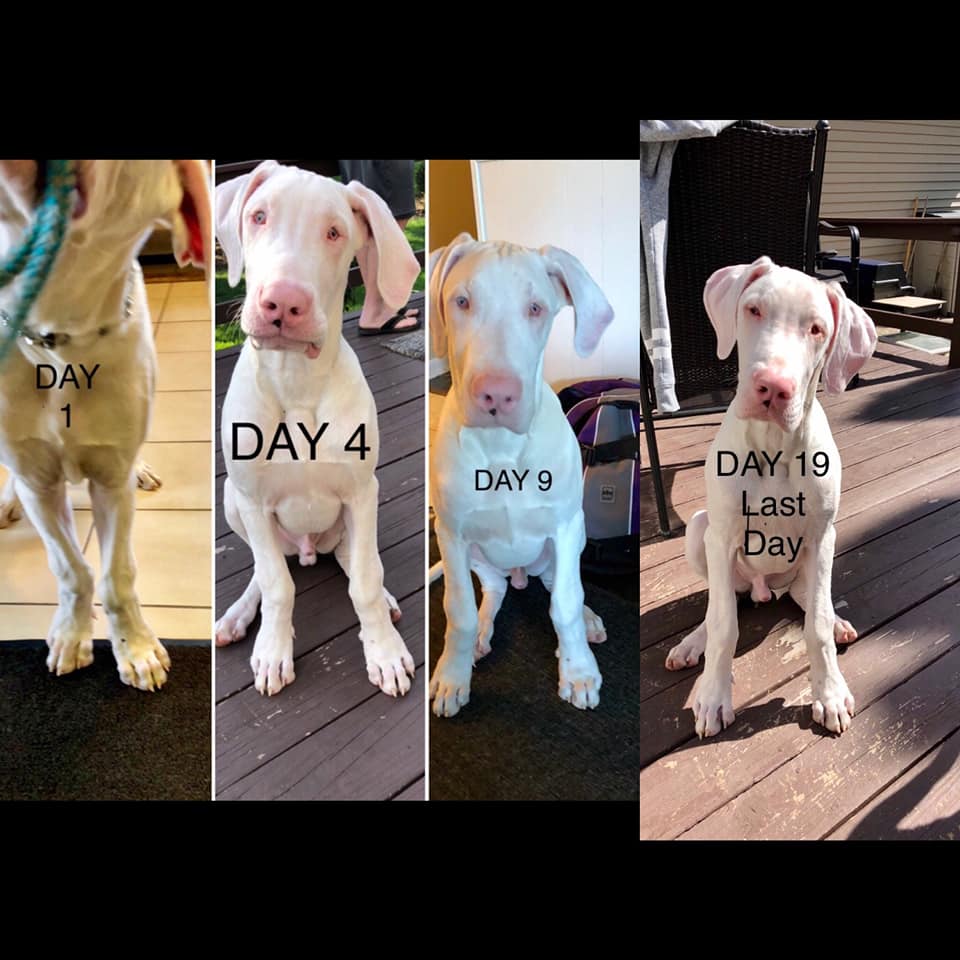
Puppies that aren’t offered adequate free-play on soft, varied terrain (think grass, sand, dirt, and gravel) or that live in homes with a lot of hard, slick floors may be more prone to knuckling, flat feet, and other orthopedic issues.
In the early stages of knuckling, you may notice:
- Weak feet (flat toes/knuckles)
- Weak ankles
- Shaking limbs when on soft surfaces
- What looks like severe knuckling when standing on a softer surface, but may correct and look ‘normal’ when back on the floor
- Ankles that appear to be moving up and over the foot, even slightly
- Legs that occasionally ‘bow out’
- Limbs that look crooked in some way
Knuckling Before and After
The great news is that knuckling (carpal laxity) is treatable and can be corrected!
The treatment for knuckling is also helpful for treating flat feet, which are another symptom of improper flooring, inadequate exercise, poor nutrition, and poor breeding practices.
BEFORE:

How to treat Great Dane puppy knuckling
There are five big changes to make when treating knuckling.
- Change Food Immediately
- Supplements
- Nail Maintenance
- Flooring
- Exercise
We are going to use the space below to outline each one, including the best foods to offer when correcting knuckling in addition to information on supplements that we recommend.
As always, consult your veterinarian.
Of course, we say to consult your veterinarian often because we really do think that you should.
However, it is extremely important to note that you find a veterinarian with giant breed experience, who is well studied in the latest research when it comes to nutrition and more. Ask questions!
When you notice the early signs of knuckling, it is imperative that you change foods immediately.
Knuckling is largely related to nutrition.
The food you choose for your Great Dane puppy MUST have the correct calcium, and phosphorus ratios.
More research is needed into the exact mechanisms behind nutrition and knuckling, but it is believed that an imbalance of amino acids and meat proteins may also contribute. For this reason, we only recommend research-backed brands for Great Dane Puppies. These brands include Purina, Royal Canin, Iam’s, Hill’s Science Diet, and Eukanuba.
A food with the ‘correct’ calcium and phosphorus ratios may still cause knuckling if it is overfed or not professionally formulated by a veterinary nutritionist!
The best Great Dane puppy foods to treat knuckling
We like to see:
Calcium at or below 1.2%
Phosphorus close behind
Calcium and Phosphorus should be balanced together as closely as possible, with phosphorus being the lower value. Calcium values of 1.2% or lower are ideal.
Science-based formulation from a company that follows WSAVA Guidelines and utilizes research and science, not marketing buzzwords (Purina, Iams, Eukanuba, Hills, Royal Canin)
If possible, look for an AAFCO statement on the bag with information about the formula being correct for the “growth of large-size dogs (70 lbs. or more as an adult)”.
Better yet, the AAFCO statement should indicate that the food was substantiated in food trials.
Ingredients: Science-backed formulation with meat, meat, and/or meat by-product meals in the first ingredients. Be wary of any food that uses an excessive amount of legumes or pea protein instead of real meat protein (which may also be linked to heart problems).
Added probiotics and ingredients such as DHA and fish oil that promote healthy brain development and a shiny coat are recommended.
NOTE: It used to be said that ‘adult food’ was the only choice for Dane puppies. Formulations and science have been updated. Puppy food may help ensure that your puppy is receiving enough of the right protein and fat for brain development and growing muscles.
Formulations, research, science and kibble diets have changed for the better in the last 10 years.
You can now choose a puppy OR an adult formula, as long as it’s formulated correctly for the growth of giant breed dogs and from a science-backed, heavily researched brand such as Purina.
Great Dane puppy foods that we recommend
Always consult with your veterinarian before a diet change or adding supplements! The brands listed below are heavily tested and researched by Veterinary Nutritionists and are thus formulated with up-to-date information about the growth of large and giant breed dogs.
These brands are recommended by veterinarians and many of the Top Breeders in the U.S.
- Purina Pro Plan Large Breed Puppy – any flavor!
- Purina Pro Plan Sensitive Skin & Stomach Large Breed puppy – TOP PICK, salmon-based
- Eukanuba Large Breed Puppy (Great for active and sporting dogs)
- Purina One Large Breed Puppy (Excellent budget option)
- Hill’s Science Diet Puppy Large Breed
- Royal Canin Giant Puppy Dry Dog food (to age 12 months) – TOP PICK, PREMIUM OPTION
- Royal Canin Giant Junior Dry Dog food (8-24 months)
- Purina Large Breed Puppy Chow
Check out THE GIANT DOG FOOD PROJECT to compare brands and values.
Whatever you do, do NOT give your Great Dane puppy a calcium supplement or multivitamin!
Nail trimming to prevent knuckling in Great Dane Puppies
Overgrown nails lead to:
- Flat feet
- Weak pasterns
- Unnecessary pressure on the toes and joints
- Altered gait/walking
- Pain
- Damage to the skin, furniture, and hardwood
- Temporary or permanent deformity of the feet & ankles
- Eventually: joint damage and arthritis
Nails must be kept short and round, not long and sharp. If they touch the ground, they are too long. If you have a puppy that is knuckling, has flat feet, or has another bone growth disorder, nail maintenance is even more important.
For tips on trimming nails, read our ‘how to trim Great Dane puppy nails’ blog post here.
Appropriately trimmed puppy nails look like this or better:
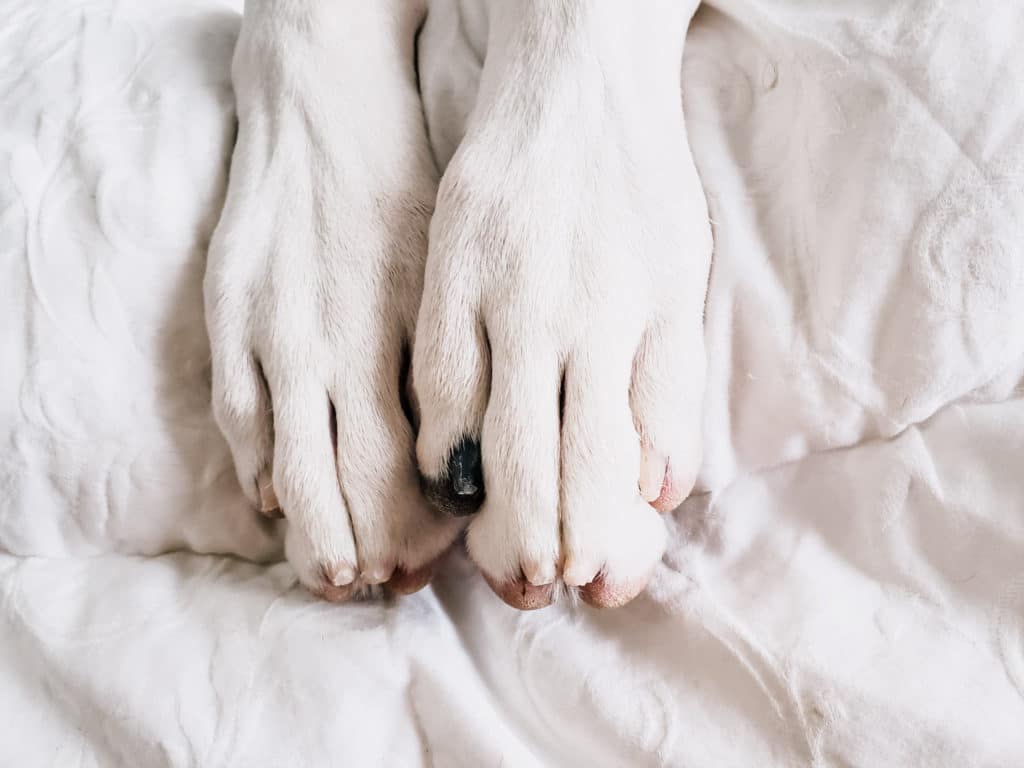
Hard and slick flooring is extremely bad for the joints and can contribute to flat feet and knuckling in Great Dane puppies.
We recommend putting down runners and traction. These clear stick-on stair treads are amazing for wooden steps!
Discourage your puppy from jumping, especially if the landing is on a hard or slick surface. Use a washable, tough bed in the crate to keep feet off the hard crate pan when crating for extended periods.
Do not allow your puppy to zoomie and slide all over the hardwood and tile floors in your home.
It is important to help your puppy strengthen those feet, tendons, and muscles.
Great Dane puppies should have large, well-knuckled feet. The toes should not be flat. We’ve included more information below on what good foot structure and strong feet should look like!
- Purina Pro Plan Large Breed Puppy – any flavor!
- Purina Pro Plan Sensitive Skin & Stomach Large Breed puppy – TOP PICK, salmon-based
- Eukanuba Large Breed Puppy (Great for active and sporting dogs)
- Purina One Large Breed Puppy (Excellent budget option)
- Hill’s Science Diet Puppy Large Breed
- Royal Canin Giant Puppy Dry Dog food (to age 12 months) – TOP PICK, PREMIUM OPTION
- Royal Canin Giant Junior Dry Dog food (8-24 months)
- Purina Large Breed Puppy Chow
Check out THE GIANT DOG FOOD PROJECT to compare brands and values.
How to strengthen weak Great Dane puppy feet
Exercise ideas for strengthening Great Dane puppy feet and pasterns:
- Lots and LOTS of free play on varied terrains such as grass, sand, and pea gravel.
- Walking up and down gently rolling hills.
- Have the puppy stand on the bed or the couch, and gently touch each side with a flat palm to encourage the puppy to ‘balance’.
- Use a stability disk or cushion. Encourage the puppy to stand with both front feet on the disk.
- When indoors, keep the puppy only on soft surfaces.
- Limit time spent walking on concrete and in the ‘heel’ position.
- Create a puppy playground and encourage your puppy to safely explore ramps, tunnels, and things that wobble a bit.
Be careful about over-using a crate (restricted movement all day and all night) or keeping your puppy on a tile or linoleum floor all day long. This practice can contribute to weak feet, knees and hips.
Make sure that your puppy receives plenty of time to move outside of the crate or X-pen when you are home.
If your puppy has a severe case of knuckling, consult with a veterinarian and certified canine physical therapist before adding any additional exercise!
Some cases of knuckling benefit from wraps to support the limbs; a professional can help you. We do NOT Recommend wrapping without professional guidance.
This puppy has weak flat feet, and weak pasterns, and shows what may be early signs of knuckling.
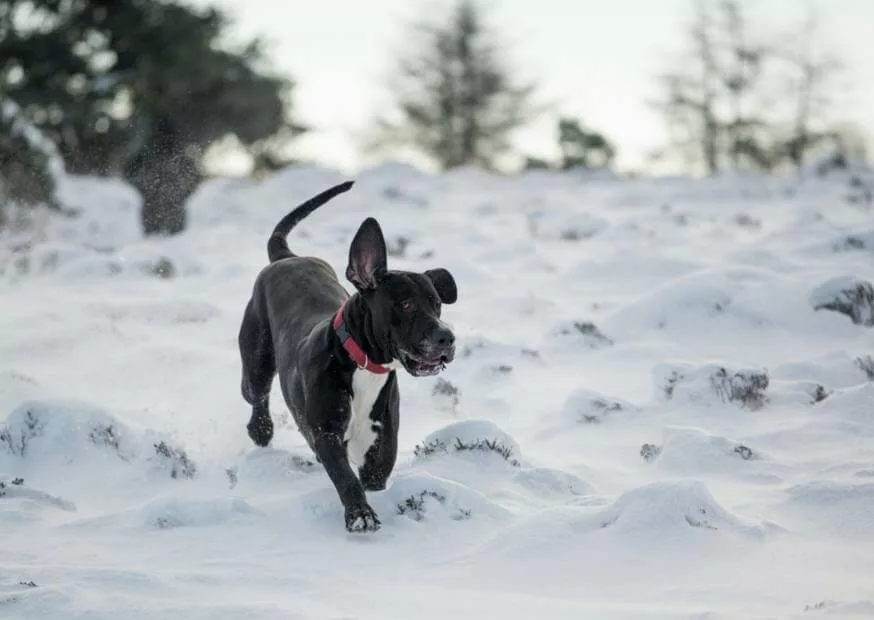
Around 5-7 weeks puppies can appear to have flat feet and early knuckling, which will correct itself if the puppy is given the correct food.
Feet and pasterns may ‘fall’ a bit following surgery (ear cropping, for example) and during teething.
It’s easy to become alarmed each time this happens, but it’s important to monitor progress toward the end goal: tight knuckles and straight limbs!
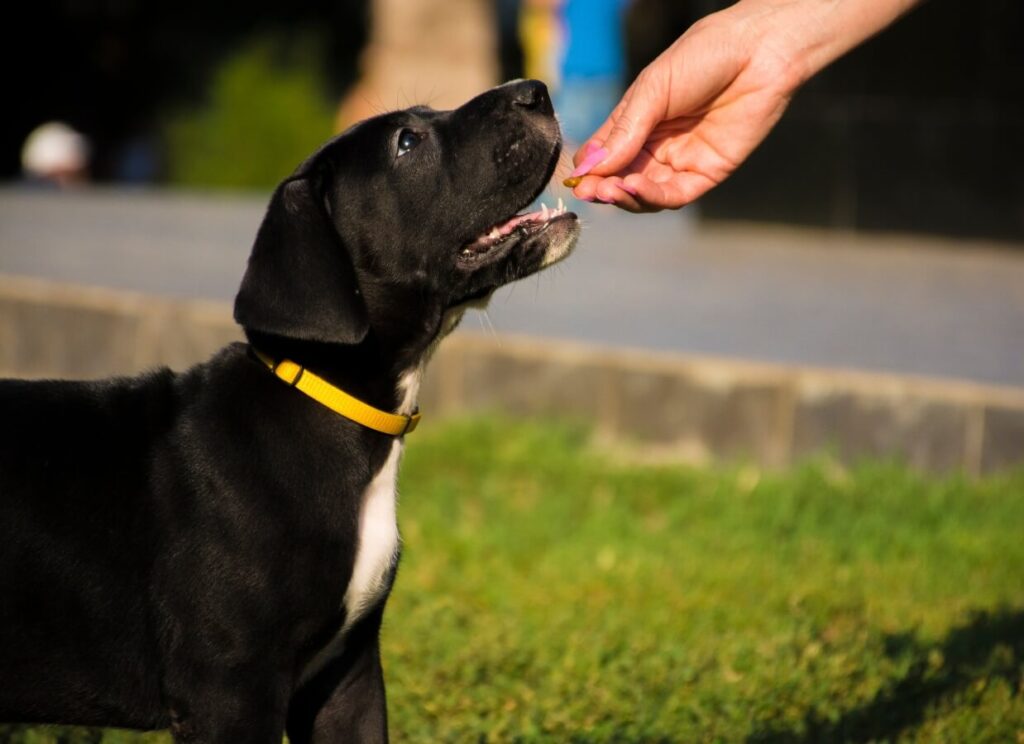
Great Dane puppy knuckling can look much worse than it is, but it’s still essential to immediately begin correcting the problem.
Failure to correct knuckling could lead to permanent deformities of the limbs that may become painful and may eventually lead to arthritis or require surgery.
Have you had a puppy knuckling? What did you do to treat it? How quickly did it resolve?
Use the comment section below to tell us about it!

